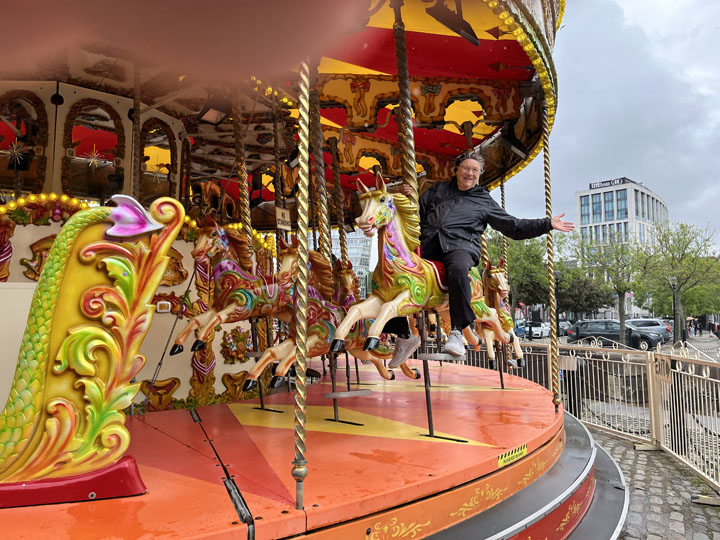Over And Back
I've been "into" ships for as long as I can remember. I grew up in New York City, during the last two decades of the great ocean liners, before air travel put them out of business. As a boy I often would ride down the West Side Highway when my father took us to Brooklyn to visit relatives. At that time all the shipping lines berthed their liners at piers on the west side of Manhattan; the bows of these beautiful vessels—the original Queen Mary and Queen Elizabeth, Île de France, Michelangelo, Rafaello, the tragically doomed Andrea Doria, Berlin, Bremen 5, Europa 2, the beautiful Independence, and—the greatest of them all, United States—would jut up above the level of the highway. I would stare at them in awe, and could name them all. They're all gone, now, except United States, who's rusting away at her moorings in Philadelphia, inevitably facing the boneyard. The very first book I ever bought, at the age of 6, was "Superliner SS United States," and I still have it.
Most of those ships have been broken up for scrap. Queen Elizabeth burned and sank: poor Andrea Doria, whose sinking I recall vividly, lies in her grave at the bottom of the ocean she once sailed. I vowed to myself that someday I would sail across the Atlantic: it took me seventy years, but by God, I finally made a transatlantic passage by ship. Two in fact: one over and one back. I went aboard Queen Mary 2, the only real ocean liner now in existence.
The Ship Is The Trip
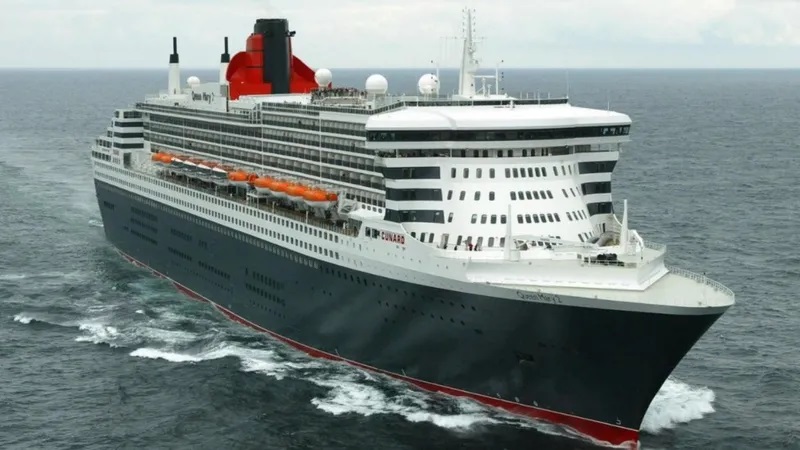
Until you get up close to a ship like Queen Mary 2 it's hard to imagine how colossal she really is. Once—I was about 14 or so—I got to stand on the pier next to United States and QM2 is actually a bit larger than that. When we got to the Brooklyn Cruise Terminal (she doesn't sail from Manhattan) the impression of size was simply overpowering. She's so big you can't see all of her at once; and she towered above the terminal building like a black-and-white cliff.
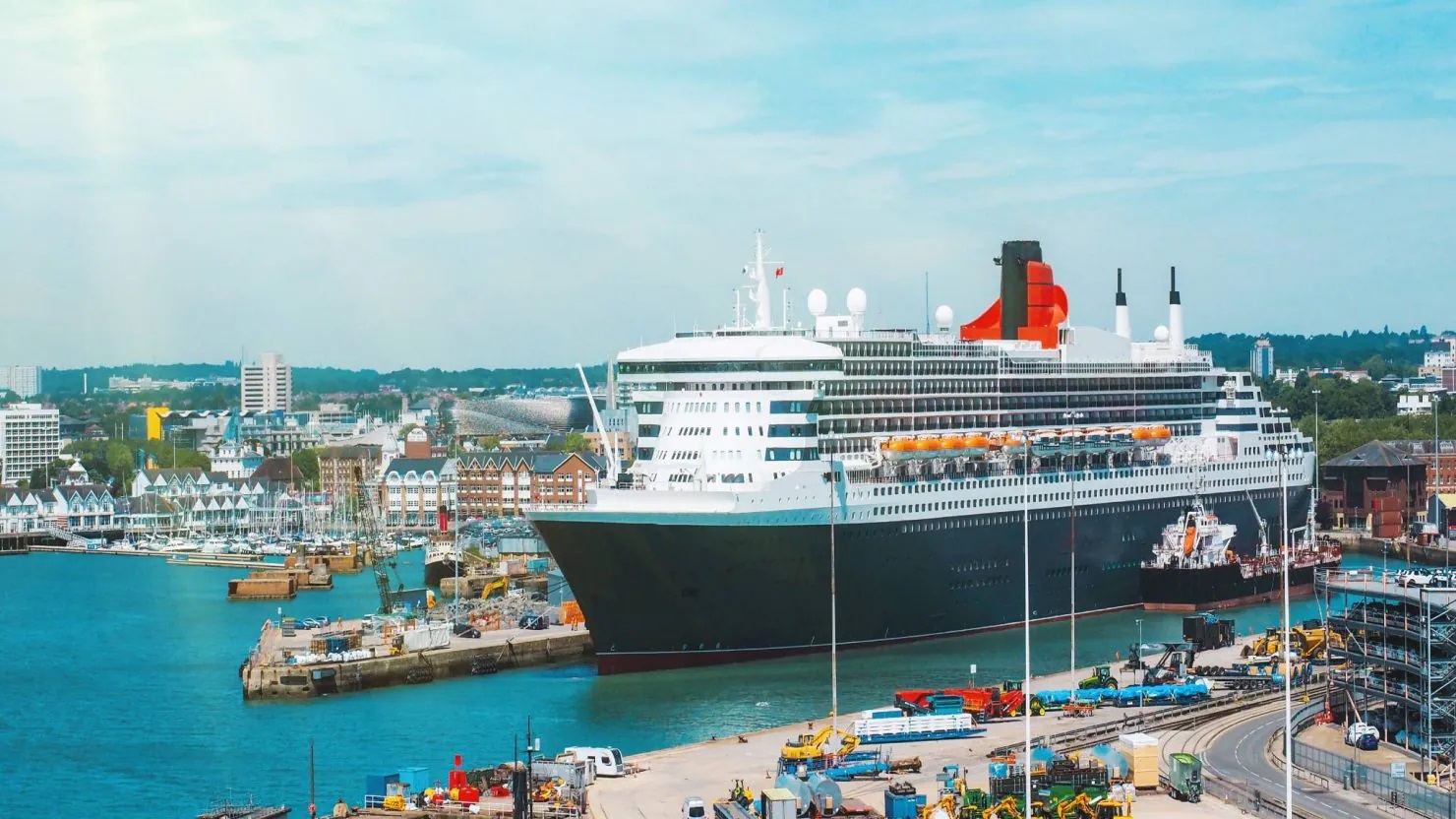
QM2 Moored In Southampton
The embarkation procedure is not unlike that for boarding an airplane: gone are the days when friends and family could come on board for a bon voyage party, and the departing passengers threw streamers into the water of the harbor.
Your properly tagged luggage is turned over to an army of baggage handlers as soon you arrive at the terminal. It's passed through an x-ray, then taken aboard to await you at your stateroom. Hand luggage is screened the same way it's done at airports, though the people doing it are far more courteous and far less imperious than the goons at the TSA screening points.
Boarding is by sections: you're given a "boarding group number" and twiddle your thumbs in uncomfortable chairs in an enormous bland room until your group is called. It took about an hour and a half once we were inside the building. Then up you go into an airplane-like tunnel along the side into the ship, and to your room. Our luggage was waiting for us in front of our door.
When we came aboard we entered via the "Grand Lobby," then were shepherded into a long corridor running the length of the deck. There elevators (excuse me, "lifts," this is after all a British ship) take you to your deck. We had a room on Deck 4 more or less midships. This location pretty much assured we'd not be bothered by ship movement. The fact is that a vessel that size isn't subject to much rolling or pitching in normal sea states. Undoubtedly had we opted for a crossing in November or December it might have been rough, but 99% of the time the ship was as steady as a hotel on land.
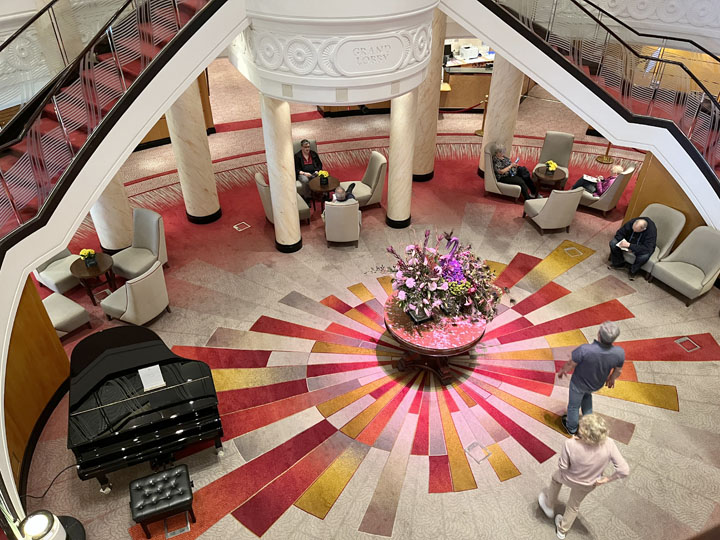
The Grand Lobby
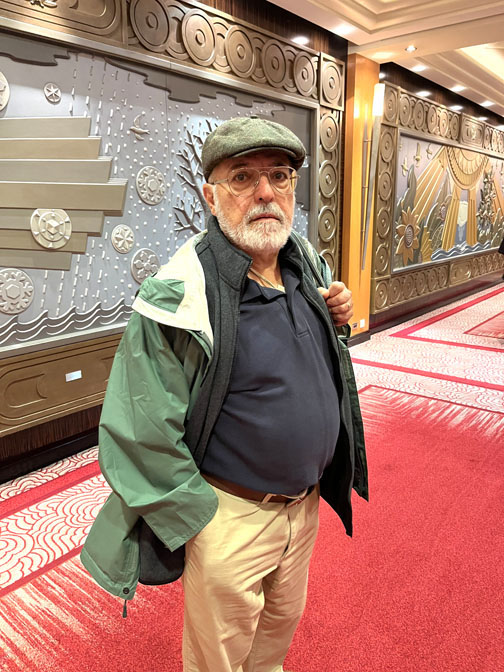
In the main corridor
We opted for an "inside" stateroom, i.e., one with no window. My wife is prone to motion sickness, so she didn't want to watch the waves go by. The inside rooms are a bit cheaper than those which have ocean views, but it sure wasn't steerage as my grandparents experienced it in the early 20th Century!
If you wanted to watch the waves there was a TV set in the room, one channel of which carried a live camera view from the bow—not that there was much to see except water once we were on our way. You could go up to one of the observation decks, the promenade deck, or sit in one of the long passages on either side where you could watch the sea through real windows. Another channel of the in-room TV gave updates on the ship's progress using the same sort of real-time map you see on airplanes, giving up-to-the-minute data on speed and position. Every day the clocks were changed to reflect the time zone in which we were: an hour forward going over, an hour back on return.
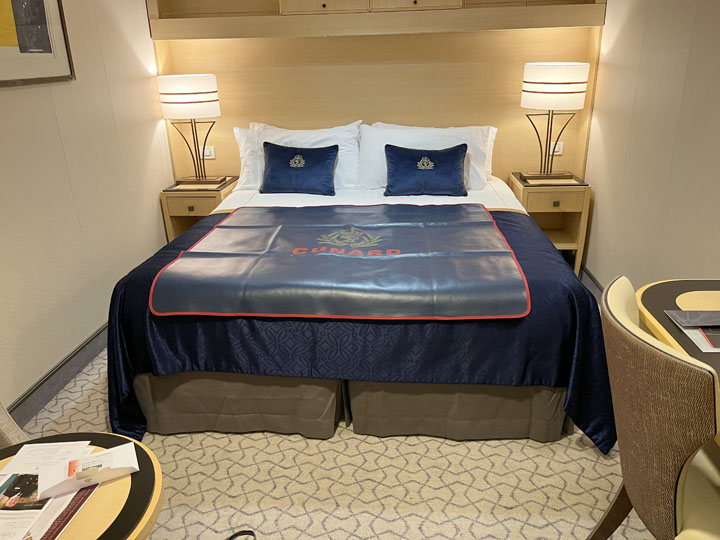
Our stateroom: small but comfortable.
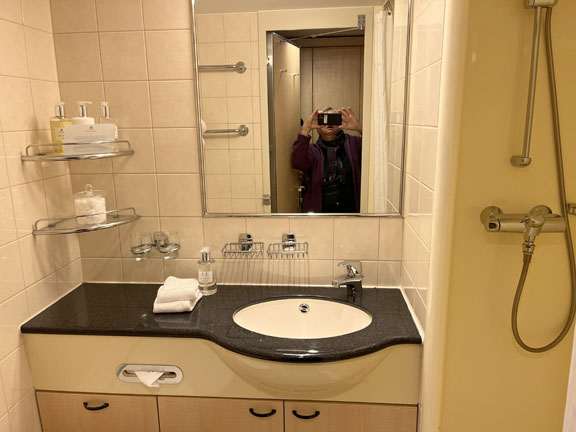
In the old days, even aboard big liners, the bathrooms were down the corridor: no more! Every stateroom has its own.
A week aboard QM2 costs more than an air ticket but not too much more; It depends on when you cross. For the price you get a real bed, good food (not Michelin star quality, but a damned sight better than the pretzels the airlines grudgingly serve on transatlantic flights), and no jet lag. There's a flossy two-level main dining room, the "Britannia Restaurant," complete with white tablecloths, obsequious waiters, and menus. Breakfast, lunch, and dinner, plus teatime in the ballroom. Four meals a day.
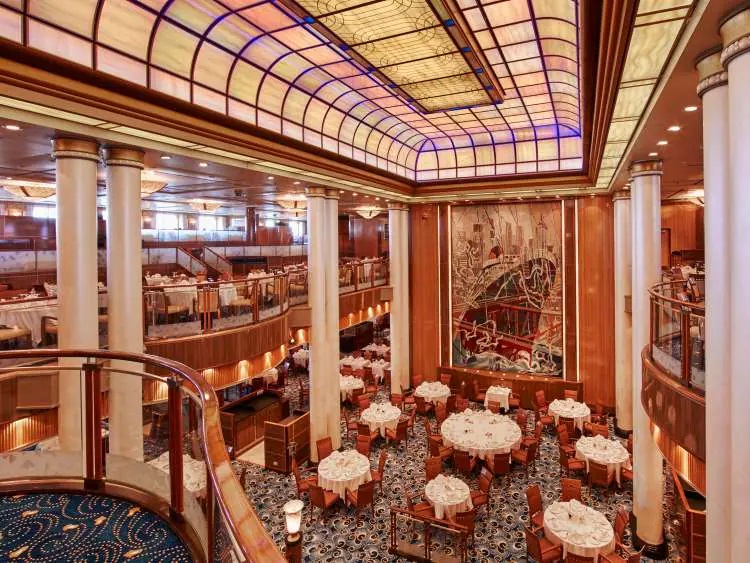
The Britannia Restaurant, the main dining venue, on two levels

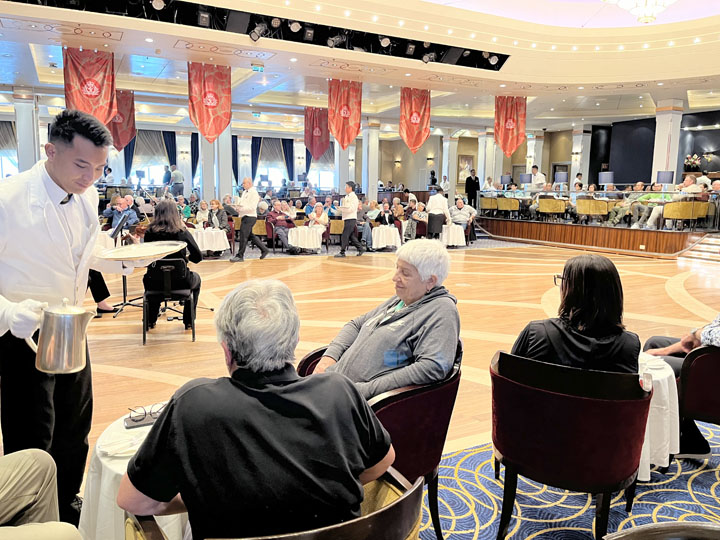
The very English custom of tea
Oh, yes, I should also mention that there was 24-hour room service. Definitely not steerage.
We departed New York in the early evening. After dropping the harbor pilot, QM2 started her way across The Pond at something like 19 knots (21 mph). She can go a lot faster (and on the return voyage, she did: more below) but Cunard's emphasis is on comfortable elegance, not speed. The transatlantic speed record is still held by United States (3 days, 10 hours, and 40 minutes) set in 1953 on her maiden voyage. QM2 takes a leisurely week to do the same Great Circle Route from New York to Southampton. OK by me!
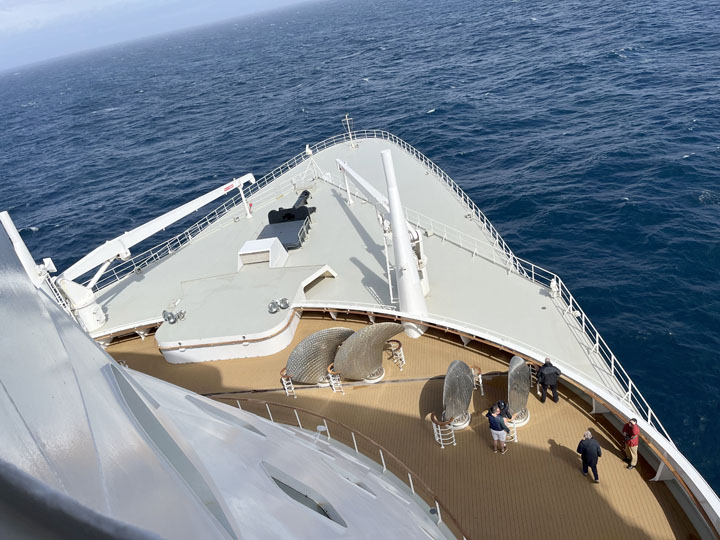
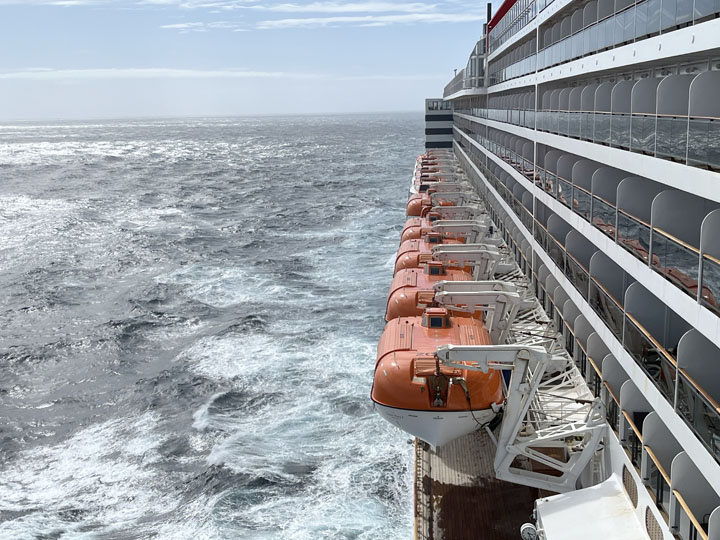
You can't get bored in a ship like this. Not only do they have a 10,000-volume library, there are endless things to do. You can take painting lessons, play card games in groups, do jigsaw puzzles, attend lectures in the room called "Illuminations," or go to the "Royal Court Theater" for shows in the evenings. There's a casino if you care to try your luck, but we avoided that. There were lectures on various topics: ethnic communities in London's East End, the British Home Front in World War Two, the history and architecture of London, New York skyscrapers, etc. These were usually in the morning; after attending one we repaired to the restaurant for lunch.
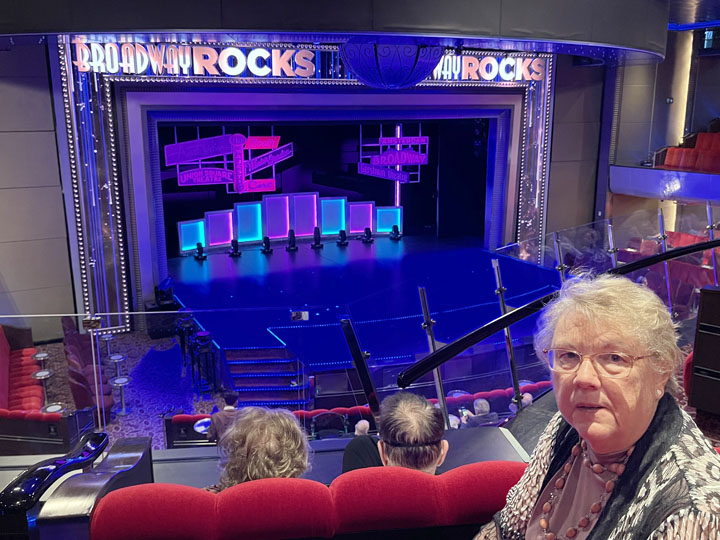
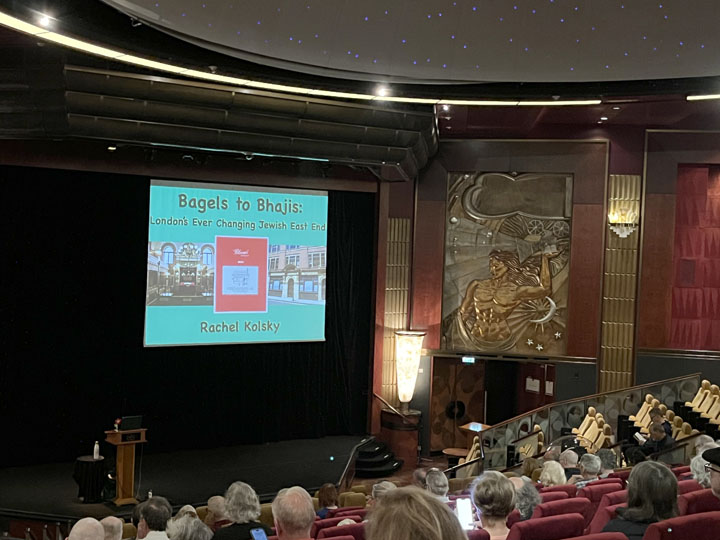
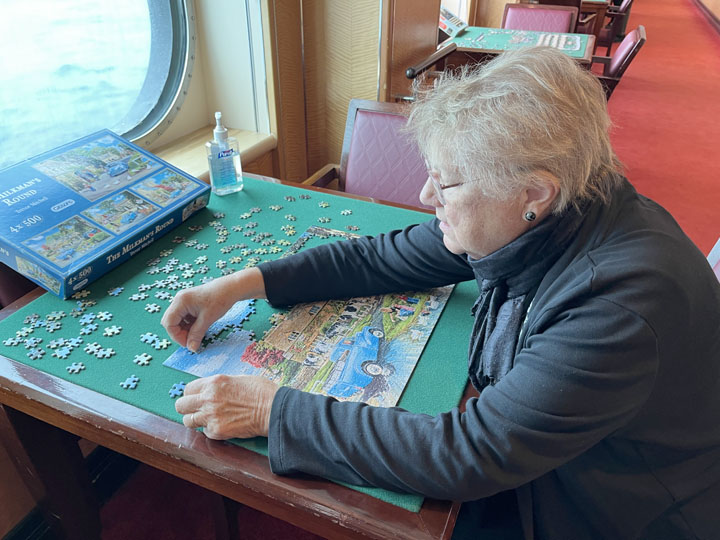
The evening shows featured musical performances with a troupe of extremely energetic dancers (including scantily clad girls, but given the large numbers of retirees on board, the costumes weren't too risqué, lest we Geezers get overly excited). If you could deal with the weather (it was wet and cold on the way over, better on the way back) there were two swimming pools.
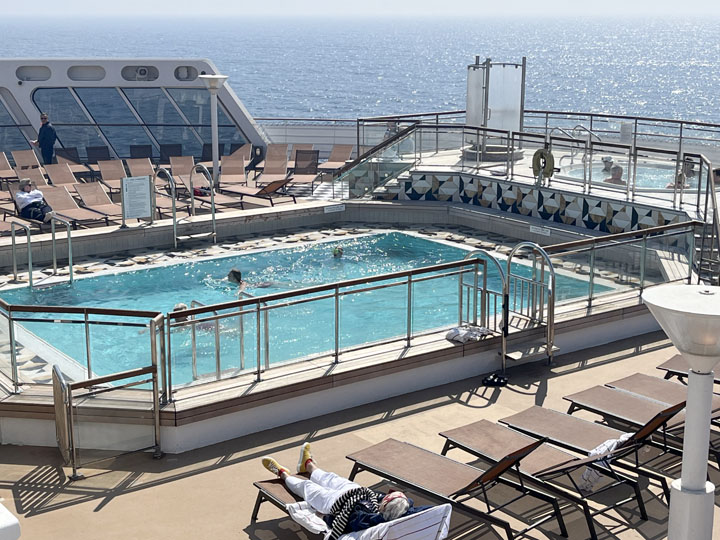
The main pool. There was another smaller one under cover.
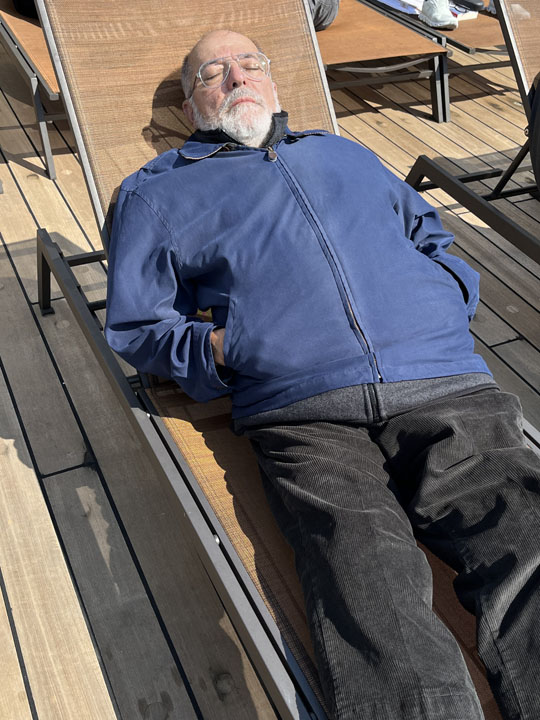
Life on the Atlantic in Spring: Sunning myself in a jacket and corduroy trousers.
The trip to England took a week, but the return was only six days. Why? Because we had "25 hour days" coming back. On the return voyage every day we set the clocks back an hour (they'd been set forward an hour going over) so we "gained" the hour we'd "lost" before. Nevertheless we arrived in New York five hours late on the return voyage.
Normally the ship docks at 5:30 AM (groan) but shortly after we'd left Southampton the Captain came on the PA system to announce that he was altering course to the north for a "medical emergency requiring shore-based treatment." We were still close enough to Plymouth that a helicopter could be sent out to pick up the passenger who was ill. Then, a few days out the ship stopped dead in the middle of the ocean. The Captain came on the PA, this time to tell us that they had stopped "...to reconfigure our power management system." I had visions of the container ship that lost power and hit the bridge in Baltimore, but we were way out at sea so there was, after all, nothing to hit. She was stopped for seven hours. A friend who is a retired Navy Captain said that it was almost certainly not the main propulsive power (which is what happed to Dali in Baltimore) but rather the secondary system that keeps the lights on and the galley ovens hot. To make up for lost time the return speed from that point was at 25-26 knots (28-30 mph), substantially faster than the outbound run. On the run into New York we passed under the Verrazzano Narrows Bridge and past the Statue of Liberty: had we arrived at 5:30 AM we'd likely not have been awake to see these!
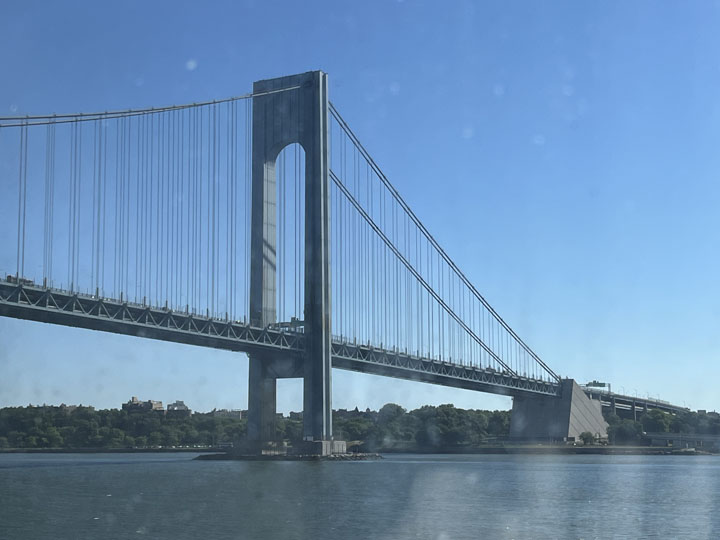
That delay actually worked out well for us: we had a hotel reserved in Manhattan, so getting in late didn't cause us to miss any connections. Disembarkation was by groups as was embarkation, and we were in the last group. People tend to forget that New York City is a major port, with a great deal of in-and-out of cargo vessels: so while we waited for our group to be called we sat on the starboard side of the ship as she was moored, watching the commercial traffic on the East River, and watching the fuel barge fill up QM2 's bunkers.
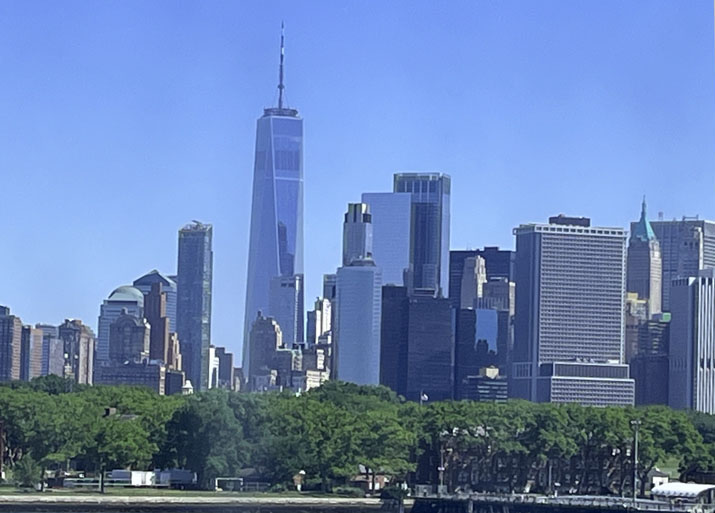
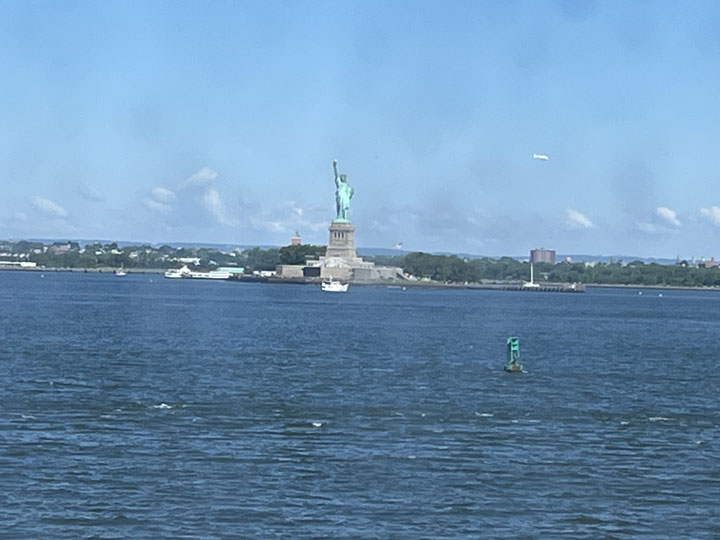
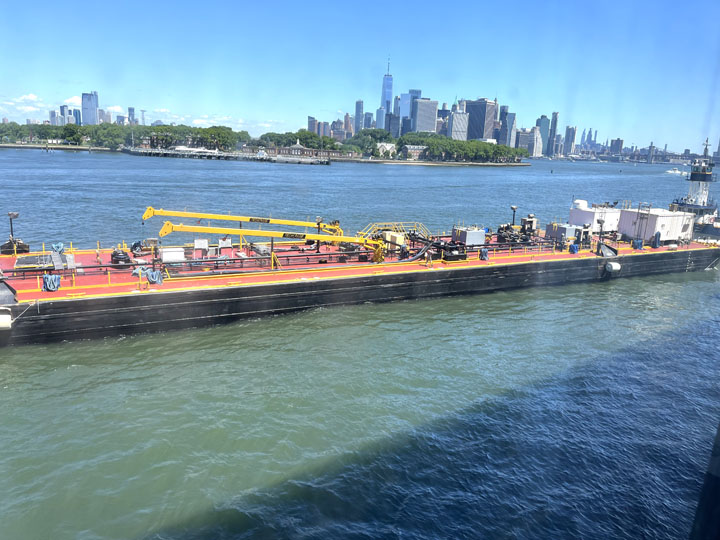
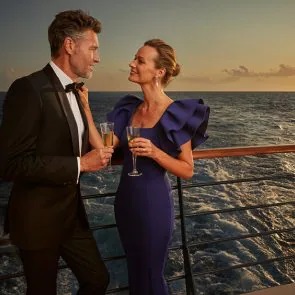 Cunard sells its product with advertising featuring Beautiful People: slinky women in low-cut gowns and virile older men in tuxedoes, cavorting elegantly about the various parts of the ship. See the image at left, which is pretty typical of their web site. There's a dress code, which asks that everyone wear "smart attire" (Cunard's words, not mine) after 6:00 PM. "Smart Attire" means a shirt with a collar (probably not more than a third of the men wore ties) and preferably a jacket, but the latter seems not to be mandatory. The tuxedo worn by the stud at left is entirely optional. Good thing: I don't own one and I already had enough to lug around Britain once I arrived.
Cunard sells its product with advertising featuring Beautiful People: slinky women in low-cut gowns and virile older men in tuxedoes, cavorting elegantly about the various parts of the ship. See the image at left, which is pretty typical of their web site. There's a dress code, which asks that everyone wear "smart attire" (Cunard's words, not mine) after 6:00 PM. "Smart Attire" means a shirt with a collar (probably not more than a third of the men wore ties) and preferably a jacket, but the latter seems not to be mandatory. The tuxedo worn by the stud at left is entirely optional. Good thing: I don't own one and I already had enough to lug around Britain once I arrived.
Twice on each crossing they have a "Gala Night" on which passengers are urged to "...put on your finery..." because it's so very, very sophisticated. Some people—mainly women—did in fact go all out and wear long gowns. We saw one elderly lady in a gold lamé pants-suit with a matching hat and shoes. She must have pretty much glowed in the dark. Despite all this emphasis on glamor (excuse me, "glamour," I keep forgetting it's a British ship), despite the advertising showing gorgeous couples, the run of the mill passenger was an affluent retiree, with a mean age of probably 75. I did in fact see a few people who looked like they had stepped out of the Cunard brochure: maybe they did.
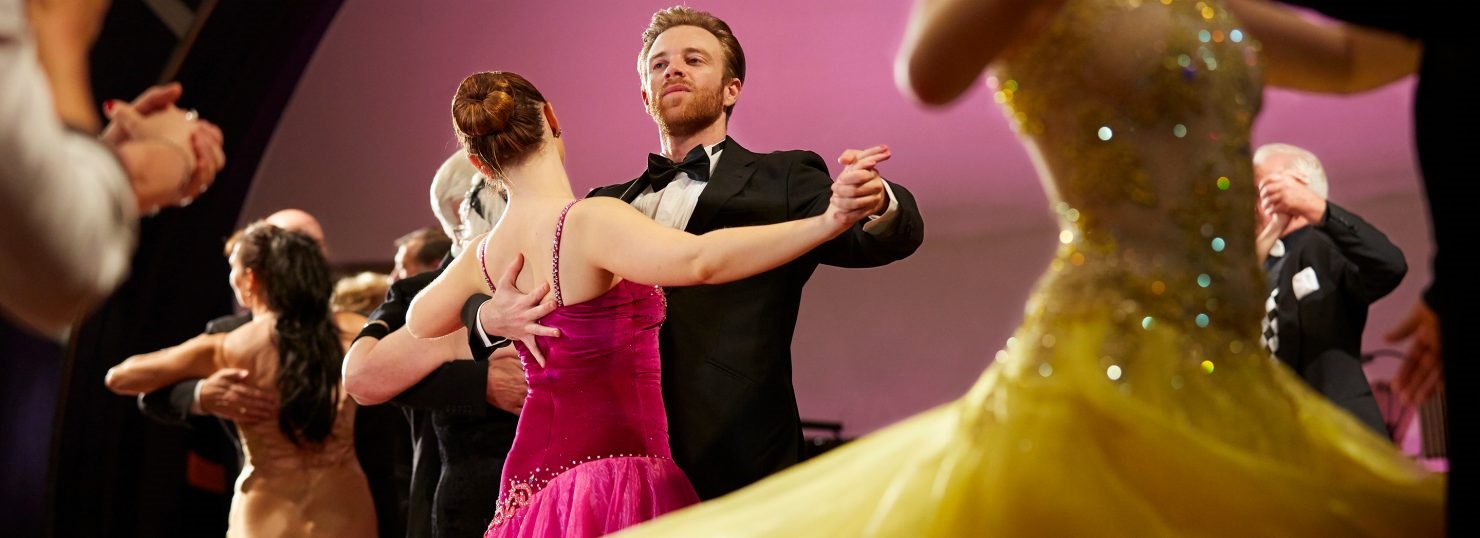
Cunard is very accommodating to disabled people (as they put it, "...those who have mobility issues...") with ramps for wheelchairs anywhere there were steps to be negotiated. There were plenty of wheelchairs and motorized scooters in use, too. Walkers were a dime a dozen. Given the average age of their passengers this is perhaps not surprising; but, hey, those people have money to spend, too. Come one, come all. Bring money.
If you want to drink, Cunard is very willing to help. There are bars and lounges all over the ship. Even in the theater and lecture hall, you can order drinks from waiters who wander by. They aren't pushy, you can wave them away if need be. Unfortunately unlike some other ship lines (e.g., Viking) you have to pay for every drink you take, even soft drinks, even at meals. Coffee, tea and water are free at meals and in the buffet but nowhere else. You can buy a "drinks package" that covers everything but it costs a fortune: $72 per day per person. Everyone in a stateroom has to buy it, too: no sharing! I think that if you tried to get your money's worth out of that package you'd end up dead of alcohol poisoning long before you ever reached land. Booze has got to be one of QM2's main revenue streams.
Certainly they didn't make any money on us. Working our fare out on a per day basis the cost was far less than we'd have paid in a hotel of the same quality; it included the room steward, the waiters, the cooks, bottle-washers, etc. I don't know what it costs to run a ship like QM2 but it must be a lot, with 1000+ crew members. Even carrying 1900+ passengers they can't be making making much, if any, profit on the basic passage contract.
Needless to say there were sales venues, hawking very, very expensive junque ($900 handbags, $1000+ jackets, insanely priced jewelry, perfumes, etc.) in the space above the Grand Lobby. God knows who buys this stuff, but we ignored it.
One thing that surprised me was that there were dogs on board. I'd thought the UK didn't allow dogs to come in without quarantine, but in recent years the rules have changed. True, the dogs had to live in kennels on Deck 11, but their owners could visit them every day. I did however see one young woman in a wheelchair with a small dog in her lap, in the dining room. A very civilized touch.
Land Ho! And Getting Around
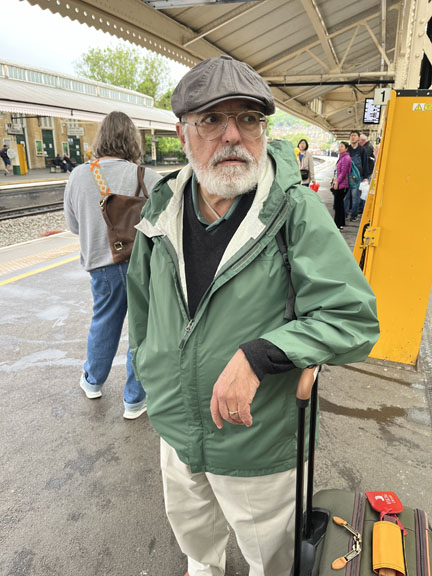 The UK has an extensive rail network; after our 2019 trip to Scotland, when we drove everywhere, we'd opted to travel by train this time. I have extensive experience driving on the left side of the road, which doesn't bother me, but driving in Scotland convinced me that at my age I'm past doing that anymore. I came home from that trip needing a nervous system transplant. So it was trains this time. Immediately upon arrival in London we went to the ticket office at Paddington, buying all the tickets for every stop we planned to make. We'd had the foresight to get "Senior Railcards," which saved us 30%, but British trains are pretty expensive, more so than those of other European countries.
The UK has an extensive rail network; after our 2019 trip to Scotland, when we drove everywhere, we'd opted to travel by train this time. I have extensive experience driving on the left side of the road, which doesn't bother me, but driving in Scotland convinced me that at my age I'm past doing that anymore. I came home from that trip needing a nervous system transplant. So it was trains this time. Immediately upon arrival in London we went to the ticket office at Paddington, buying all the tickets for every stop we planned to make. We'd had the foresight to get "Senior Railcards," which saved us 30%, but British trains are pretty expensive, more so than those of other European countries.
Although the trackage belongs to the government (hence the designation of "National Rail") different companies buy the right to run their trains over different routes. The trains for the Great Western Railway were nice: clean, cool, and comfortable. But those of some other lines not so much. Cross Country and Transpennine trains were a trial. Sometimes—depending on destination—the coaches were very full, often as crowded as the IRT subway in rush hour: more than once we had to stand. There were never enough luggage racks for large suitcases. In one instance people were sitting on the luggage in the racks! When we were stuck in the aisles, sat on our suitcases.
Since we'd planned to be away for six weeks in all, were unsure about QM2's dress code, and hadn't been to the UK in 30 years, we packed for all possibilities, 95% of which never happened. What I'm saying is that—as I always do—I brought too much stuff. Far too much: my suitcase was consequently so heavy that getting it into and out of train coaches was, to be charitable, a PITA. My own fault: I over packed. British trains always have a sizeable gap between the coach and the platform, plus the coach is usually higher than the platform. Getting that @#@#@$!!!! suitcase up into one was a real strain. Luckily people already in the coach were almost always willing to help. Thanks to them we managed, but next time I pack I'll get out everything I think I need, then put at least half of it back in the closet.
We landed at Southampton on schedule, mid-afternoon. The next stage was to entrain for London, where we were to spend a week. Southampton to London takes about an hour and a half, an easy journey with a train more or less every hour. The train—it was a Great Western Railway line—was clean, fast, and not crowded. There were some other runs from one city to another that were seven to ten hours. We realized fairly early on that we had to plan on a half-day—sometimes a full day—to get from Point A to Point B.
The Undergound is a marvelously efficient way to get around in London. Having grown up riding the New York City subways I can negotiate any such system anywhere in the world. London's is one of the best, with great maps and signage. We'd bought "Oyster Cards," tap-to-pay cards that you use to enter and exit. That saved us money, as did the Senior Rail Passes. They could be reloaded at any station when they ran low.
I'm now too old for London. The last time I was there was 1993, and in the intervening years the city has changed so much I'd not have recognized it if it weren't for the fact that I watch a lot of British television on Acorn and Britbox. About a bazillion skyscrapers have been built, some of them quite oddly shaped and with curious names:
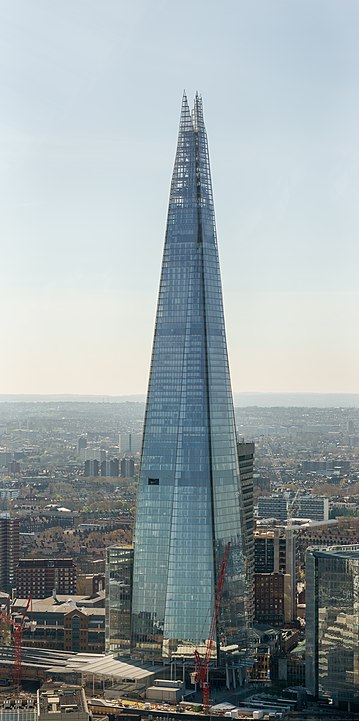
"The Shard"
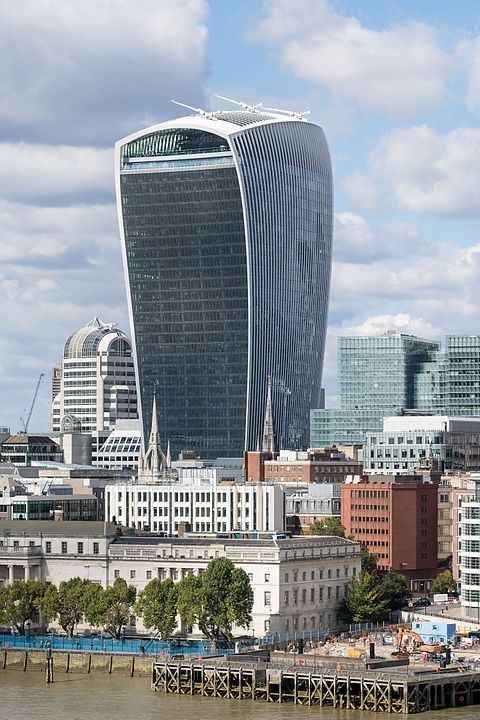
"The Walkie-Talkie"
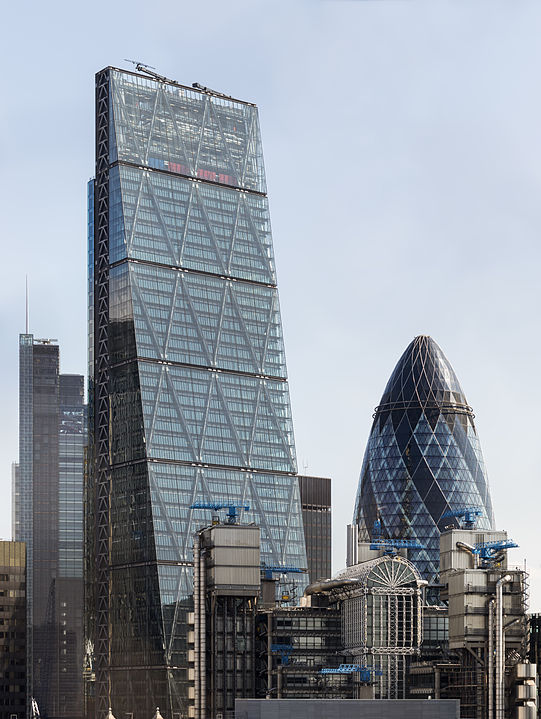
"The Cheese Grater," and behind it, my favorite, "The Gherkin"
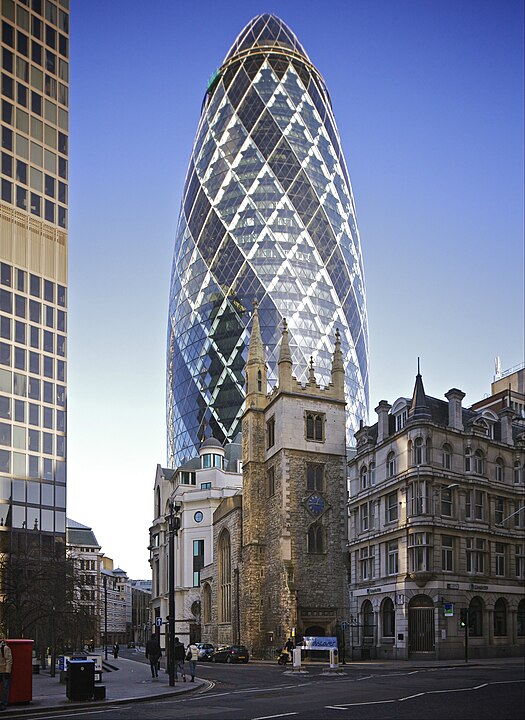
"The Gherkin" named for the sort of pickle it resembles
In one of these buildings—I'm damned if I can remember which one—there's an observation deck from which one can view the city from a great height. Needless to say, in keeping with the universal desire of humans to get as high up as possible, we ascended to it. There's a cost for everything in London: we "paid" by buying a couple of drinks, one of hot chocolate and one of what was alleged to be coffee, for the piddling sum of...$27.00, a real bargain!
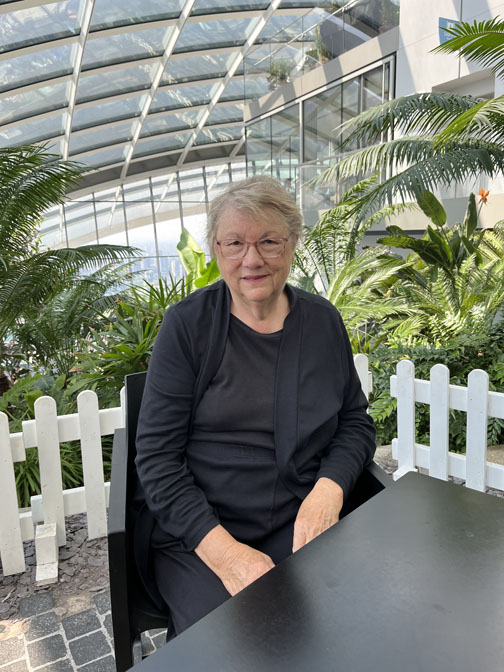
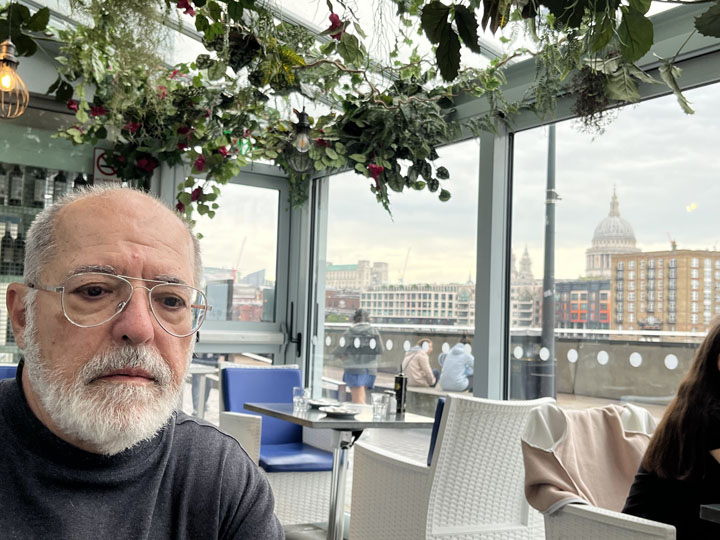
My wife loved the Sky Garden. I was contemplating those $27.00 cups of coffee and hot chocolate.
We stayed in a "Premier Inn" near the Tower of London, which turned out to be a fortunate choice. The Premier Inn chain is one of clean, relatively inexpensive (for the UK) budget hotels; we stayed in several others and were wholly satisfied with them.
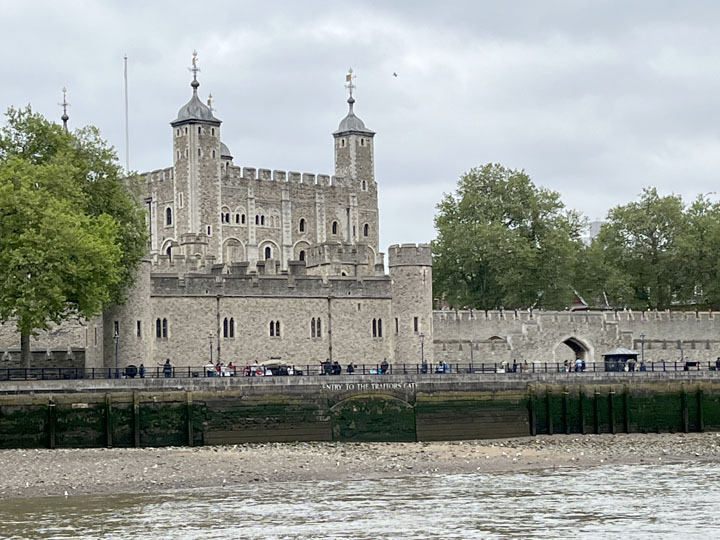
The Tower of London, as seen from a cruiser on the Thames
Almost the first thing we did upon checking into the hotel was to hoof it down to the famous Tower Bridge, the 19th Century engineering marvel that's on all the postcards and is emblematic of London.
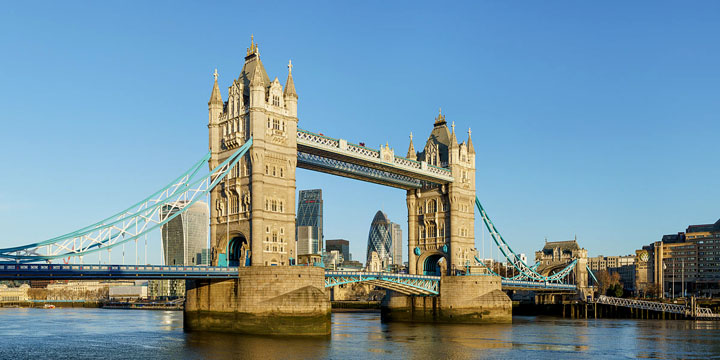
It turns out that we arrived on a Sunday of a Bank Holiday weekend. The Tower Bridge was jammed with people. It seemed everyone in and around London decided that a stroll across the Bridge was what was needed to celebrate, so there were tens of thousands of people, crossing and re-crossing the Bridge: at times we had to elbow our way through the crowd.
We wanted to go to Greenwich. Rather than take a train we took a short "cruise" on the Thames to get there. Greenwich is the location of the "Prime Meridian," i.e., Longitude 0°, separating the Eastern and Western hemispheres. One of the things you must do as a tourist is stand with one foot on either side of the Meridian, so that you're in both hemispheres at once.
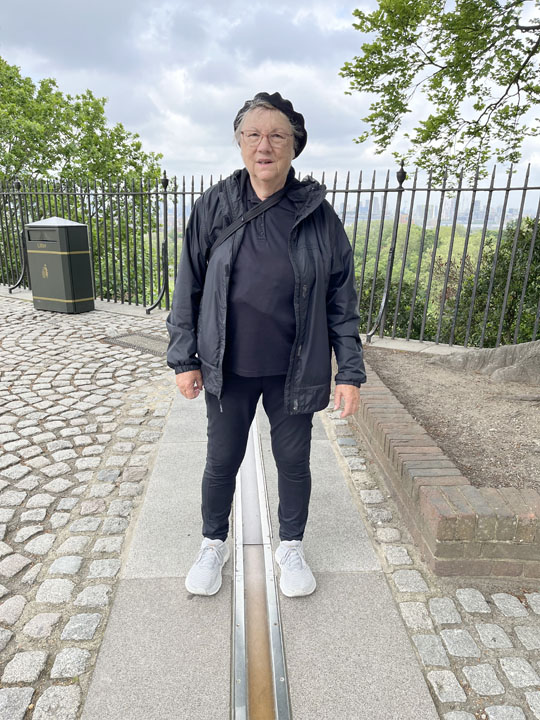
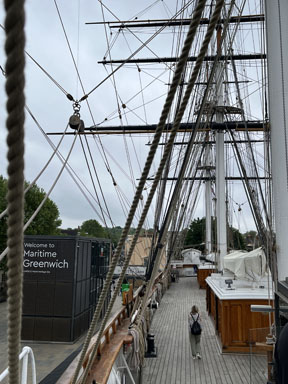 We also visited Cutty Sark, a "tea clipper," and the fastest sailing ship ever built. She brought chests of tea from China to slake the thirst of the English for this beverage. I believe that the reason the English drink so much tea is because their coffee is horrible, very nearly undrinkable. In the hotels where we stayed, "coffee" was made in machines that offered a variety of options: we always chose"café Americano," which resembles American coffee only in that it's dark, hot, and presumably has caffeine in it. There are people in England who even drink instant coffee and like it, but we were spared that. The machine stuff was bad enough. I think we need to send coffee missionaries over there to bring them the Truth of Coffee.
We also visited Cutty Sark, a "tea clipper," and the fastest sailing ship ever built. She brought chests of tea from China to slake the thirst of the English for this beverage. I believe that the reason the English drink so much tea is because their coffee is horrible, very nearly undrinkable. In the hotels where we stayed, "coffee" was made in machines that offered a variety of options: we always chose"café Americano," which resembles American coffee only in that it's dark, hot, and presumably has caffeine in it. There are people in England who even drink instant coffee and like it, but we were spared that. The machine stuff was bad enough. I think we need to send coffee missionaries over there to bring them the Truth of Coffee.

London is a hotbed of theater, old and new. There were innumerable advertisements in the Underground for plays that were being performed or coming soon. Since we both like Shakespeare's works, we went to the re-constructed "Shakespeare's Globe Theater," a faithful recreation of The Bard's playhouse in Southwark. We also attended two more or less contemporary plays: "Witness For The Prosecution," based on an Agatha Christie story; and "Cabaret," the current re-iteration of which is pretty racy. Both were very well done.

"Witness For The Prosecution" was staged in the London County Hall, set up as a courtroom.
Twelve members of the audience were selected to be the "jury."
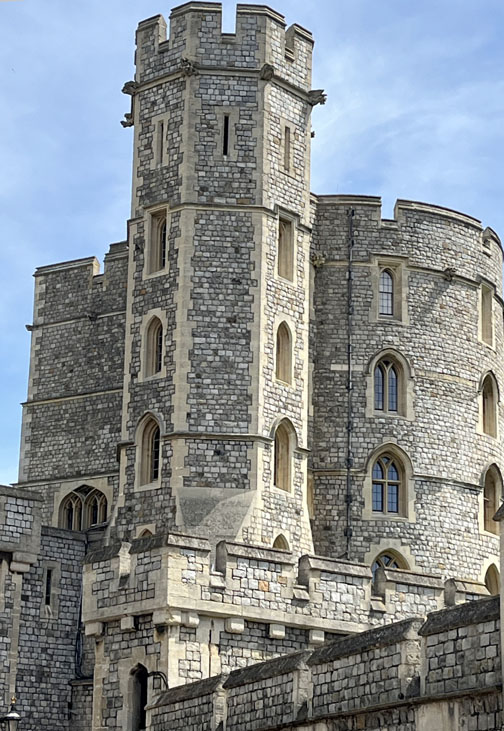 Windsor Castle
Windsor Castle
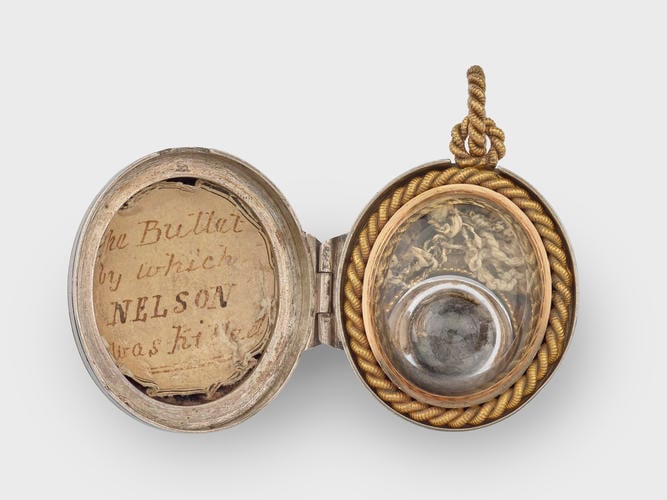 Windsor is a short train ride from London, well worth taking the time to visit. Windsor Castle is an ancient fortress, the burial place of several monarchs (including the late Queen Elizabeth II). Windsor Castle makes the White House look like a Boy Scout camp. The museum aspect is exceptionally well done; included in the collection is an amazing artifact, the musket bullet that killed Admiral Horatio Nelson at the battle of Trafalgar. Someone dug it out of the Admiral and preserved it in a locket. A significant, if grisly, bit of history.
Windsor is a short train ride from London, well worth taking the time to visit. Windsor Castle is an ancient fortress, the burial place of several monarchs (including the late Queen Elizabeth II). Windsor Castle makes the White House look like a Boy Scout camp. The museum aspect is exceptionally well done; included in the collection is an amazing artifact, the musket bullet that killed Admiral Horatio Nelson at the battle of Trafalgar. Someone dug it out of the Admiral and preserved it in a locket. A significant, if grisly, bit of history.
Windsor is much less frenetic than London. It has a longish pedestrian-only street for shopping, whence I bought a hat. The sort of baseball-style caps Americans favor were actually pretty scarce (not that I'd have worn one anyway) but these flat caps were pretty common. I hate to look like a tourist (even though perforce I am one). A baseball cap was not to be contemplated, so I bought a flat cap from a street vendor. Like everything else these days, my "English" cap was made in China.
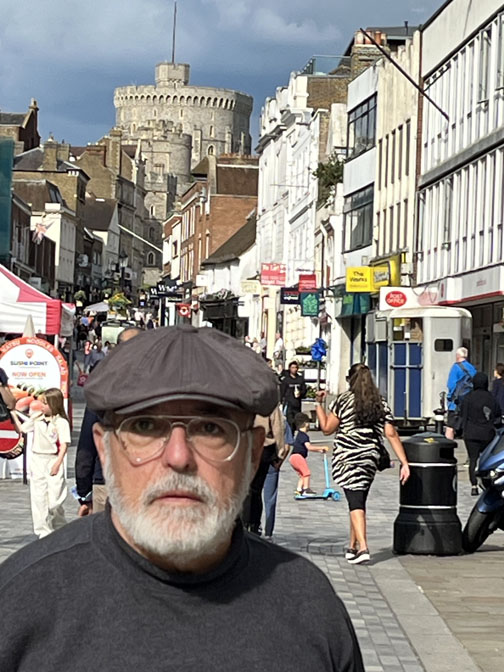
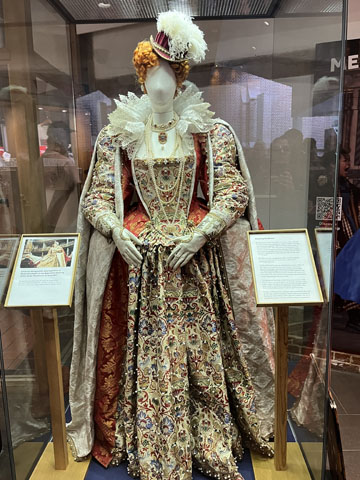
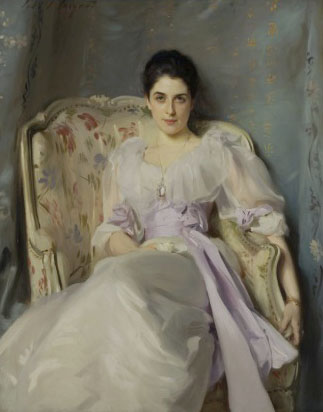 After returning from Windsor we went to the Victoria & Albert Museum, which was something of a disappointment. It was jammed with tourists. We'd been there in 1993, but it's changed so much we hardly recognized it. We tried the adjacent National History Museum, which was even worse. We then tried the Tate Gallery, which was much better. There was an exhibit of works by John Singer Sargent I wanted to see. Sargent made a tidy living by painting flattering portraits of rich women: he was a masterful painter who knew his own value, and got it.
After returning from Windsor we went to the Victoria & Albert Museum, which was something of a disappointment. It was jammed with tourists. We'd been there in 1993, but it's changed so much we hardly recognized it. We tried the adjacent National History Museum, which was even worse. We then tried the Tate Gallery, which was much better. There was an exhibit of works by John Singer Sargent I wanted to see. Sargent made a tidy living by painting flattering portraits of rich women: he was a masterful painter who knew his own value, and got it.
At left, a queen's dress at the V&A. At right, Sargent's "Portrait of Lady Agnew"
At one point we walked across Kensington Gardens, glimpsed (from a distance) Kensington Palace, where someone Royal lives; and plonked ourselves down across from the Royal Albert Hall. We were sitting under a statue of Queen Victoria. God alone knows how many paintings, statues, and other art works celebrate Queen Victoria, but they're everywhere. Reading between the lines I concluded that she had an ego greater than Georgia O'Keefe's, which is really saying something. When she wasn't commissioning statues of herself she was commissioning statues of her beloved Prince Albert. He definitely doesn't get the "coverage" Queen Victoria has, but he's well remembered.
We found ourselves in the Bayswater section of London somehow. I wanted to eat English food, since, after all, I was in England. But English food is hard to find outside pubs: all the restaurants seem to be Indian, Thai, or Italian (we did find a couple of decent Greek ones). There was a pub cleverly named the "Bayswater Arms" that looked promising, where I ordered a steak and ale pie. It was okay but later I had better examples.
Bath
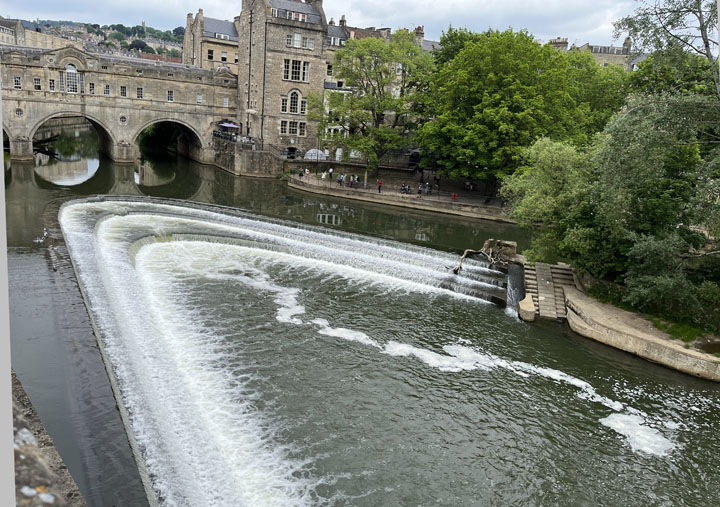
The Famous "Weir" In Bath, With Pultney Bridge At Upper Left
Somewhere along the line from New York to England, probably on the London Underground, both of us contracted horrific colds (mine, which lasted for weeks, later developed into mild pneumonia). Luckily we had a place for recuperation, in Bath, the next stop.
Bath is ancient: in Roman times it was the site of—what else?—thermal baths for the Roman residents. The Romans were really hot on baths (ha, ha): there are hot springs in the area that feed the bathing pool. So when the Romans came they said to themselves, "Hot damn! [ha, ha] Let's build a bathhouse here!" They did. There was an exorbitant entrance fee to get in, which we didn't pay because we'd seen the baths in 1993.
We'd rented a self-catering apartment, which given our colds was exactly what we needed. A nice sitting room, a good bedroom, and a kitchenette; small grocery stores within easy walking distance, and a chance to rest. Bath isn't a big place: a week there is really too long, but by having booked the apartment for week we were able to relax and start recovering from our colds without missing any of the sights.

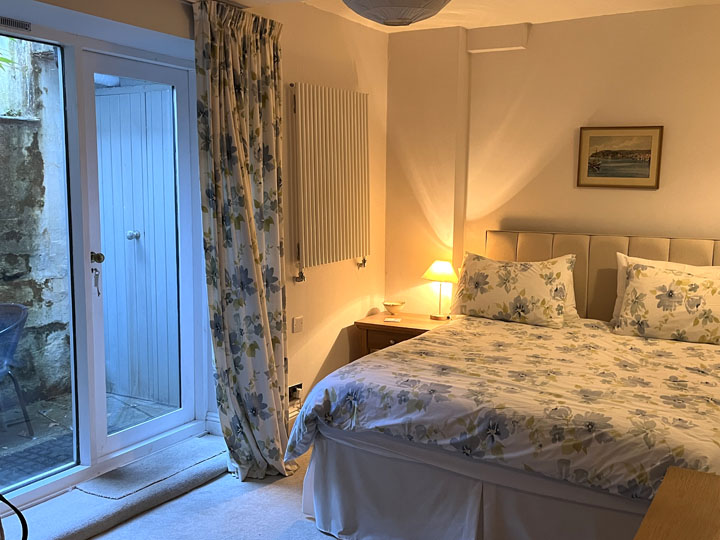
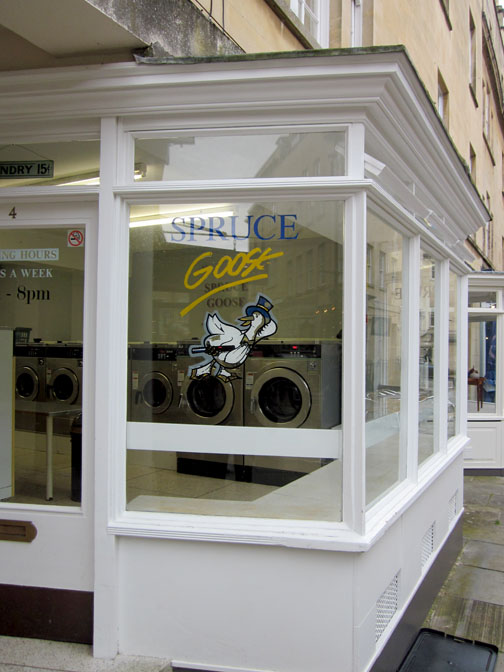 One of the major hassles of traveling is that you soon run out of clean clothes. There were some laundrettes in QM2, which were free, but always crowded. In Bath, our rental was on a quiet side street; just a hundred yards or so away was a pedestrian area with a couple of decent restaurants and...wait for it...a real laundrette, called by someone with a sense of humor, "The Spruce Goose." It had coin-operated washers and dryers. While it wasn't cheap, it was close, it had adequate facilities, and we were glad to be able to use it. Our rental had one of those oddball laundry machines that wash and dry (I've never seen them anywhere except in the UK) that could handle a couple of pairs of underpants and perhaps a shirt, but that was the limit of its capacity. The Goose was a Godsend after a week in London, as was the apartment that allowed us some "recovery time."
One of the major hassles of traveling is that you soon run out of clean clothes. There were some laundrettes in QM2, which were free, but always crowded. In Bath, our rental was on a quiet side street; just a hundred yards or so away was a pedestrian area with a couple of decent restaurants and...wait for it...a real laundrette, called by someone with a sense of humor, "The Spruce Goose." It had coin-operated washers and dryers. While it wasn't cheap, it was close, it had adequate facilities, and we were glad to be able to use it. Our rental had one of those oddball laundry machines that wash and dry (I've never seen them anywhere except in the UK) that could handle a couple of pairs of underpants and perhaps a shirt, but that was the limit of its capacity. The Goose was a Godsend after a week in London, as was the apartment that allowed us some "recovery time."
Our apartment was very conveniently located. It was between the "Royal Crescent," a group of 19th Century terraced houses for the rich people of the time (come to think of it, for that matter, it's still for rich people) and "The Circus," a large open park that is—as the name implies—circular.
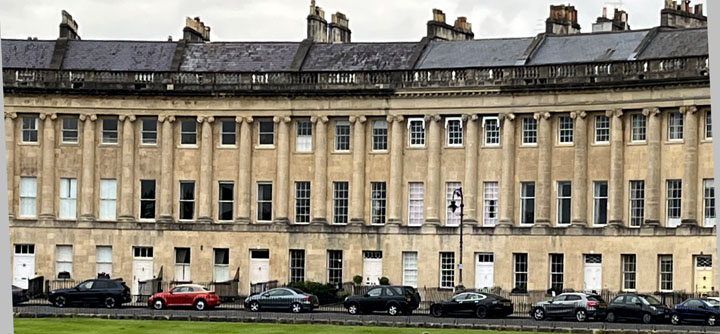
One of the river Avons (or would that be "Rivers Avon"? We were told there are nine rivers with that name in England) runs through 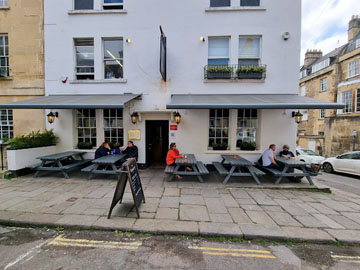 Bath. It is not the one associated with Shakespeare. We took a boat ride, a nice hour, pretty and scenic. We walked a lot on this trip. I must have walked over half of the East End of London, but even in a small city like Bath we walked and walked. At one point we got lost and ended up at a supermarket a long way from our apartment, far enough that we took a cab back.
Bath. It is not the one associated with Shakespeare. We took a boat ride, a nice hour, pretty and scenic. We walked a lot on this trip. I must have walked over half of the East End of London, but even in a small city like Bath we walked and walked. At one point we got lost and ended up at a supermarket a long way from our apartment, far enough that we took a cab back.
Bath has some decent restaurants, including a Turkish one (I've never before eaten in a Turkish restaurant) and the usual plethora of non-English-food places. A couple of small places in the pedestrian area near The Spruce Goose were fine, but there was one very, very good place across the street from our apartment. I heartily recommend "The Chequers" on Rivers Street to anyone going to Bath. One of the best places we ate anywhere in England: it actually has a Michelin Star.
Liverpool
We more or less passed through Liverpool, en route to York. This was one of our worst train rides. The first train was late—not uncommon on British trains, we discovered—so we missed all our original connections. We had been told, however, that this was of no importance: "Just take the next train," was the advice we got. The train to Liverpool was vastly overcrowded. It seems that at the first stop (Bristol) there were two simultaneous music events, and pretty much everyone in the UK was attending one or the other of them. We had to stand for most of the trip, there were no seats to be had. nor were there any available luggage racks.
Luckily our hotel (another Premier Inn) was right next to the Liverpool station so we didn't have to walk very far. This was good because, frankly, the streets of Liverpool were littered (London was surprisingly clean) and a charitable description of the people we saw would be "...a zoo."
Liverpool is of course the home of THE BEATLES, so if you were a diehard fan of THE BEATLES who absolutely had to see the childhood home of John Lennon and Penny Lane (which we did, from a tour bus) you'd be okay. Personally I have no particular interest in THE BEATLES or what passes for "music" that they recorded. The tour guide on the bus—a born-and-bred Liverpudlian—had the colossal effrontery to describe John Lennon and Paul McCartney as "...the two greatest musical geniuses who ever lived..." which, would, I think, have greatly offended Bach, Beethoven, Haydn, Mendelssohn, Mozart, and a whole host of others. But let that pass, those people are all dead. We did, perforce, see the larger-than-life-sized statue of THE BEATLES on the Liverpool waterfront.
To give the city its due, Liverpool is doing its damnedest to change its image from a brawling seaport town to something else. The waterfront has been gentrified with many chi-chi shops and overpriced restaurants, though it's not in the execrable taste of, say, Washington DC's "National Harbor" development. They have a long way to go yet. There was a carousel, among other entertainments. Click on the image to see it in action!
We had dinner in what was alleged to be a German restaurant, in which I had a roasted pig's knuckle that—I swear I'm not making this up—I could have used an axe to cut, it was that hard. That was on top of a lunch in an Italian place which served arancini that were the size of softballs and about as flavorful.
After two nights there, necessitated by the vagaries of British trains, we left for the town of Penrith in the Lake District. Amazingly we made all our connections without problems. We always had to make changes, some of them only a few minutes apart. If we missed one it was twiddle our thumbs for the time it took for the next train to arrive, but that time we got lucky. We even got seats.
The Lake District
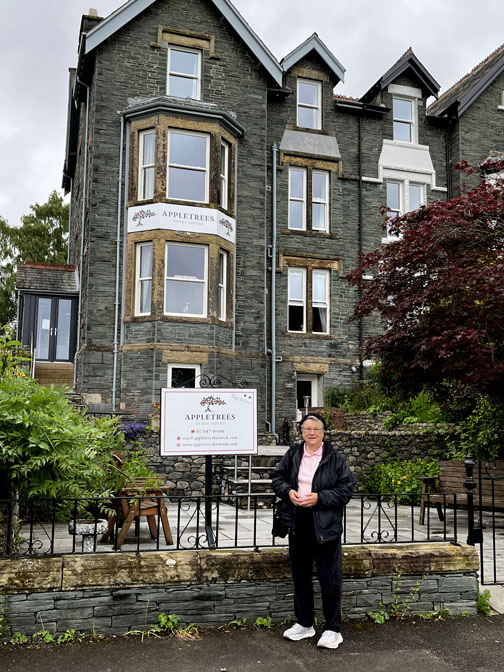 Penrith is merely a place to catch a bus to Keswick (pronounced "Kes-ick," the "W" being silent). Keswick is the Dog Capital of the UK. There were dogs everywhere. The British are very sensible about dogs, and make no complaints about dogs in restaurants, shops, parks, and even on trains and the Undergound. It's a viewpoint we here in the USA could profitably adopt. We saw lots of dogs everywhere we went but Keswick took the Dog Biscuit. It seemed at times we were the only people without a dog or two (or three). I'll add that nowhere, not once, did we ever encounter a load of dog poop on the streets, not even in London or Liverpool. The dogs didn't bark, they didn't fight, they were perfectly polite to each other and to the humans around them. If you asked someone to allow you to pet a dog, permission was always given. Having lost our dog two months to the day before we started the journey, we absolutely need a Dog Fix now and then: all the dogs in Keswick really helped.
Penrith is merely a place to catch a bus to Keswick (pronounced "Kes-ick," the "W" being silent). Keswick is the Dog Capital of the UK. There were dogs everywhere. The British are very sensible about dogs, and make no complaints about dogs in restaurants, shops, parks, and even on trains and the Undergound. It's a viewpoint we here in the USA could profitably adopt. We saw lots of dogs everywhere we went but Keswick took the Dog Biscuit. It seemed at times we were the only people without a dog or two (or three). I'll add that nowhere, not once, did we ever encounter a load of dog poop on the streets, not even in London or Liverpool. The dogs didn't bark, they didn't fight, they were perfectly polite to each other and to the humans around them. If you asked someone to allow you to pet a dog, permission was always given. Having lost our dog two months to the day before we started the journey, we absolutely need a Dog Fix now and then: all the dogs in Keswick really helped.
 My wife has a penchant for Bed-and-Breakfast places, and she picked a good one in Keswick, "Appletrees." This is in an old Victorian-era house. It had very fine breakfasts, but—as is true of nearly all B&B's—no elevator (excuse me, I mean no "lift"). Our hostess hauled our bags up to our room on the top floor, thank goodness. I'd have got a hernia doing that. Appletrees was conveniently located a short walk from the bus station,
My wife has a penchant for Bed-and-Breakfast places, and she picked a good one in Keswick, "Appletrees." This is in an old Victorian-era house. It had very fine breakfasts, but—as is true of nearly all B&B's—no elevator (excuse me, I mean no "lift"). Our hostess hauled our bags up to our room on the top floor, thank goodness. I'd have got a hernia doing that. Appletrees was conveniently located a short walk from the bus station, 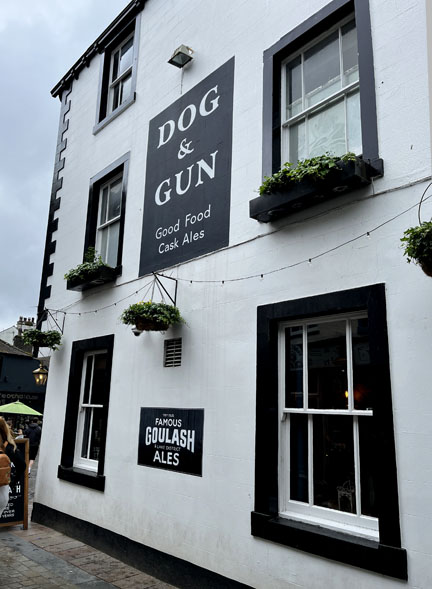 from the National Park on Derwent Water, from the sights of Keswick, and from a decent pub, "The Dog & Gun." At the Dog & Gun I had another steak and ale pie, much better than the one I got in Bayswater.
from the National Park on Derwent Water, from the sights of Keswick, and from a decent pub, "The Dog & Gun." At the Dog & Gun I had another steak and ale pie, much better than the one I got in Bayswater.
Another of the sights in Keswick worth seeing is the Derwent Pencil Museum. I know, I know, it sounds ridiculous, but it seems that part of the world is rich in graphite; the pencil-making trade flourished in Keswick and still does. A really interesting thing is that during World War Two, the factory made special pencils with escape maps rolled up inside and tiny compasses under the erasers, for use by airmen in case they got shot down. No doubt this saved some lives. It also has on display what has to be the largest pencil in the world.
The place isn't called the "Lake District" for nothing. There are several lakes, of which Derwent Water is only one. We took a short boat ride on it just to say we did. Then we hopped a bus or two (by that point we were getting very adept at riding buses) and went around the other famous locations. We had visited most of these in 1993 so didn't bother with Wordsworth's "Dove Cottage" (complete with daffodils, I understand) nor Beatrix Potter's farm. Incidentally, in 1993 we went to the latter site: in the kitchen hanging from a rafter is a shotgun. I commented on this, and the docent said, "Mrs Potter wasn't sentimental about Peter Rabbit when he got into the garden."
York
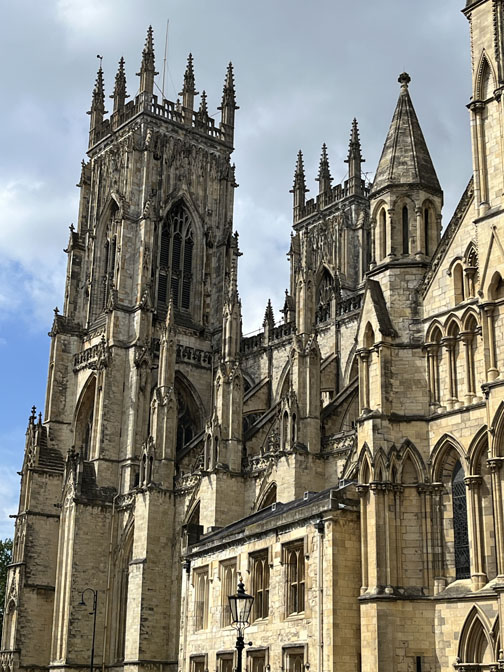 We left dog-friendly Keswick by bus for Penrith mid-morning: the first train we took was fine but subsequent ones (we had two changes) were extremely crowded. On this stage of the trip we encountered a group of four fearsome, hysterically happy, thoroughly drunk women with numerous tattoos and multi-colored hair. They were on their way to Newcastle for the races and had been celebrating well in advance of arrival. Those ladies hauled our stuff up like it was packed with feathers, and objected to being addressed as "ladies" when I thanked them for doing so. On this run there were of course no seats: we stood in the vestibule of the coach for 3 hours!
We left dog-friendly Keswick by bus for Penrith mid-morning: the first train we took was fine but subsequent ones (we had two changes) were extremely crowded. On this stage of the trip we encountered a group of four fearsome, hysterically happy, thoroughly drunk women with numerous tattoos and multi-colored hair. They were on their way to Newcastle for the races and had been celebrating well in advance of arrival. Those ladies hauled our stuff up like it was packed with feathers, and objected to being addressed as "ladies" when I thanked them for doing so. On this run there were of course no seats: we stood in the vestibule of the coach for 3 hours!
York is interesting and attractive, far nicer than Liverpool. It's major feature is York Minster, a magnificent medieval cathedral. The Minster was within walking distance of our hotel (another Premier Inn). It's the central point of the city, as well as also a jump-off point for a couple of van tours we took out into the Yorkshire countryside.
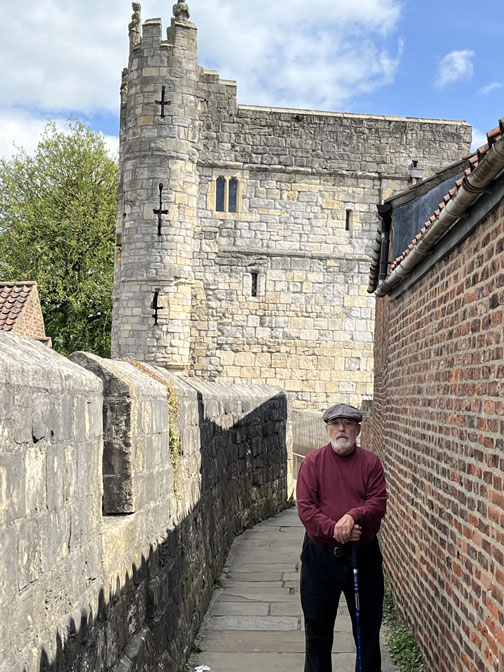
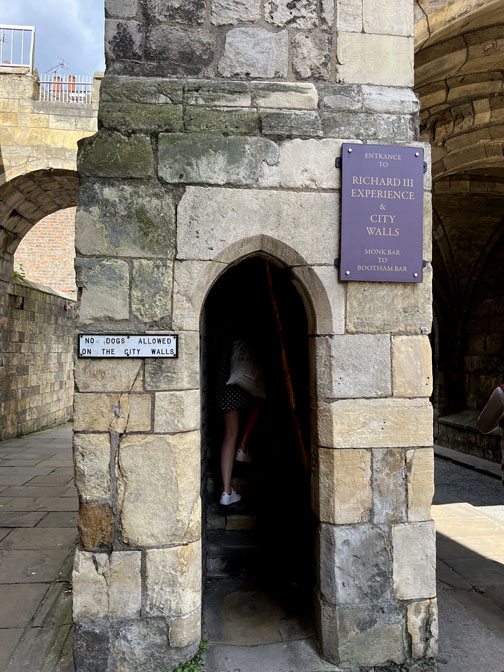
We walked the walls of the city. They date to the days when cities needed walls to keep Those People from burning the city down. Much of the medieval defensive barrier is still intact, so tourists can get up and watch for invading armies, or maybe just to take nice pictures. You can even go up in some of the watchtowers, if you are a) so inclined; and b) not claustrophic. We're not claustrophic but neither were we so inclined.
The Dales And The Moors
The first of our van tours was to the Yorkshire Dales, specifically to "Darrowby," the fictional town in the TV series "All Creatures Great And Small," which we watch regularly. It really is the village of Grassington: we were turned out into the cobblestoned village square: it was odd to see this place so familiar from television, only minimally changed from the 1930's setting of the show. Unfortunately we arrived a few days after the village had been "dressed" for filming. The local shops had reverted to their 21st Century look.

"Skeldale House," the fictional site of "James Herriot's" veterinary practice
in the fictitious town of "Darrowby." Note the cobblestones in the square!
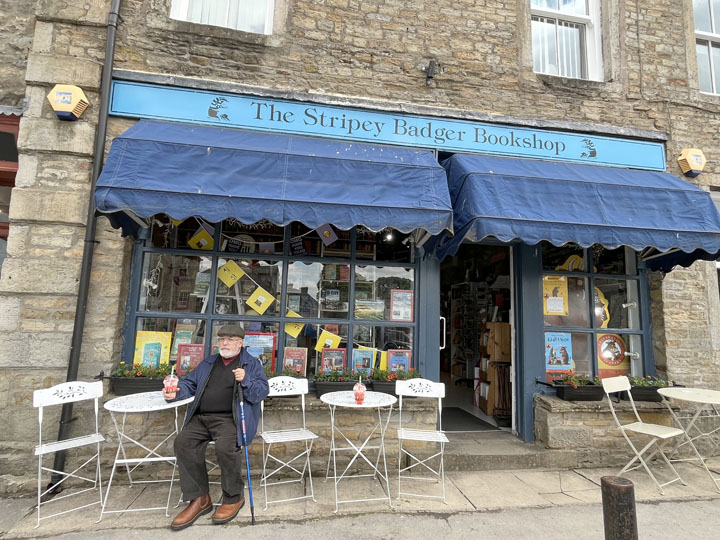
By a curious coincidence, in 1993 when driving around the Yorkshire Dales we had stopped in a small town named Askrigg. As soon as I got out of the car I was instantly hit with a sense of deja vu. I knew for a fact that I'd never been in Askrigg, but I also knew I had been there, if you catch my meaning. It became clear why when we entered the local pub. On the walls were production stills from the first iteration of "All Creatures Great and Small" that we had watched in the 1970's. Askrigg had then been chosen as the site for "Darrowby," and I'd seen it so many times I "knew" the place. How odd that I found myself in both "Darrowbies" 31 years apart.
On that tour we also saw the church where "James" and "Helen" were married, and "Helen's Farm." It was on the roof of the stone barn that "James" first kissed "Helen." The place is instantly recognizable to anyone who's watched the show.
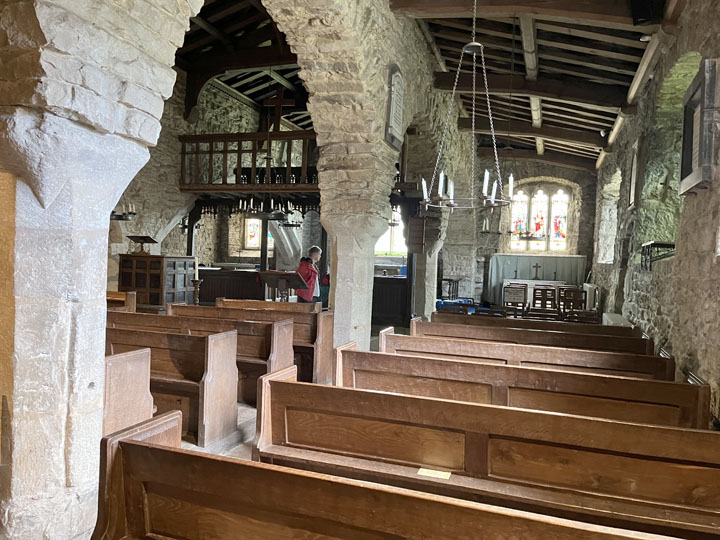
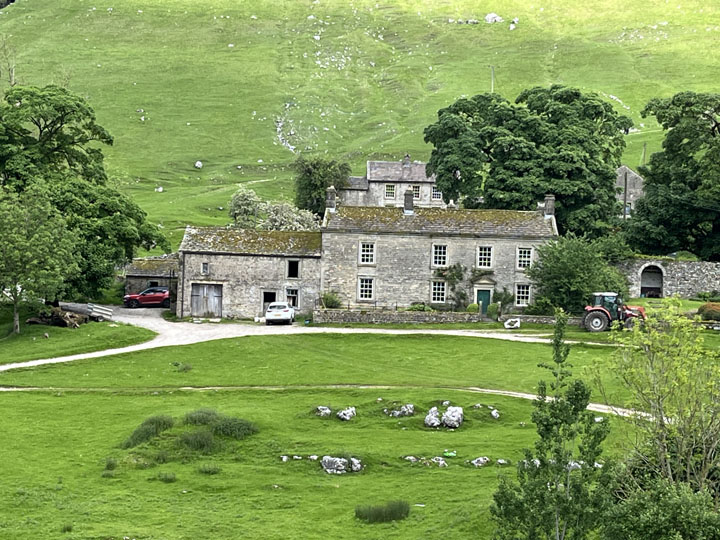
Dotted here and there around Yorkshire (and elsewhere) are ruined abbeys. When Henry VIII decided he'd had enough of the Pope's nonsense about "No, you can't have a divorce," he simply declared that he was the new head of the real church, the Church of England. You can do that sort of thing if you're a ruthless tyrant. Once he was the head of the C of E, he went about closing Catholic monasteries and confiscating their assets. His soldiers stripped out all the valuable stuff: gold, silver, jewels, etc., leaving only the shells of the buildings behind when they left. The monks decided enough was enough, so they left for other and safer occupations. So the monasteries and their churches stood empty and ripe for the thrifty Yorkshiremen to come and take their stones to build their own new houses. Waste not, want not...
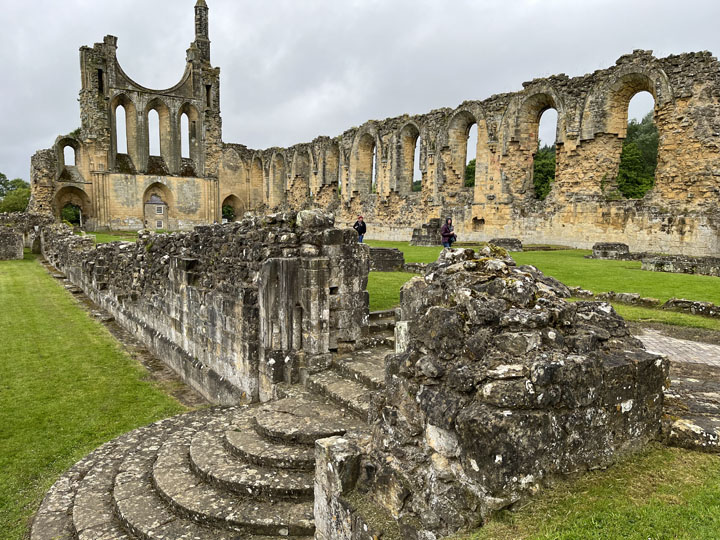
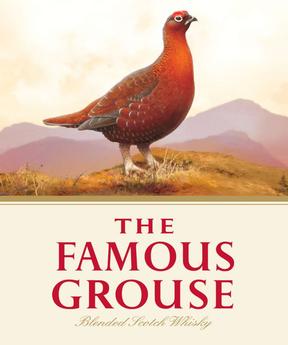 The second van tour was to the Yorkshire Moors. Some would regard these as desolate, but not me. I found them beautiful, if a bit bleak. The wind was terrific and it was cold, but I'm glad I saw them. In addition to the ubiquitous sheep (sheep are everywhere in Yorkshire: it wouldn't surprise me to see one in a pub) we saw a red grouse, the same bird that's on the bottle of the "Famous Grouse" brand of scotch whisky (note I left out the extra "e" in that word).
The second van tour was to the Yorkshire Moors. Some would regard these as desolate, but not me. I found them beautiful, if a bit bleak. The wind was terrific and it was cold, but I'm glad I saw them. In addition to the ubiquitous sheep (sheep are everywhere in Yorkshire: it wouldn't surprise me to see one in a pub) we saw a red grouse, the same bird that's on the bottle of the "Famous Grouse" brand of scotch whisky (note I left out the extra "e" in that word).
Interestingly, this bird is found in North America as well as northern Europe. The state bird of Alaska is the "Willow Ptarmigan," (Lagopus lagopus ) so the Red Grouse is a subspecies: Lagopus lagopus scotica. Same critter. In Alaska the birds turn white in winter; I don't know if they bother in England and Scotland. It's an iconic bird of the moors, immensely popular with rich folks who will pay a fabulous sum to shoot one. If you own a "grouse moor" in Yorkshire, you're rolling in money.
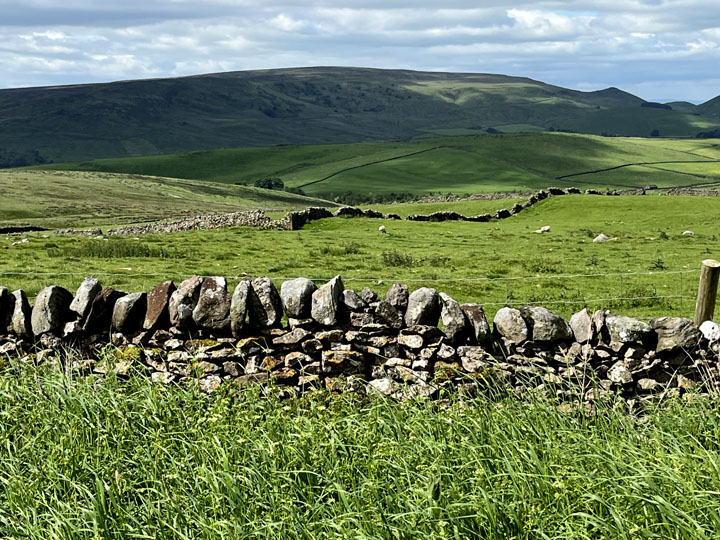
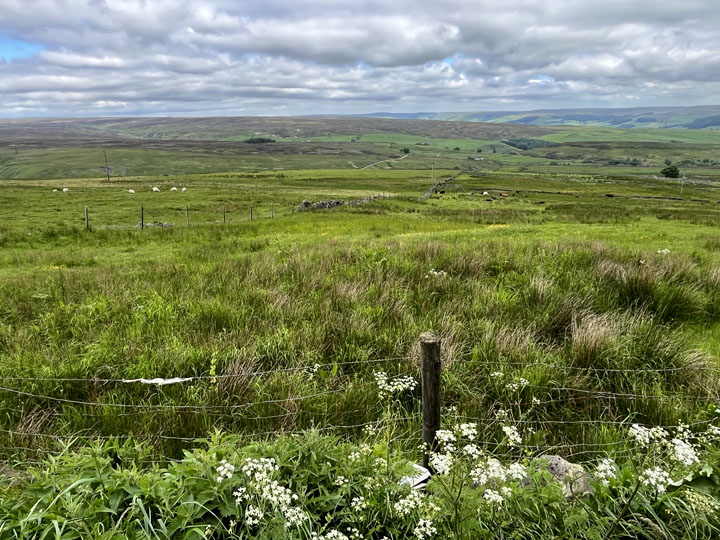

Another part of the tour was a short ride on a steam train to Whitby, a seaside town. There's a couple of amusement arcades there that reminded me of the Coney Island of my childhood. Again, dogs were in great numbers. For some inexplicable reason, the Kaiser's High Seas Fleet shelled Whitby in 1914. God knows why. A resort town couldn't have had much strategic importance.
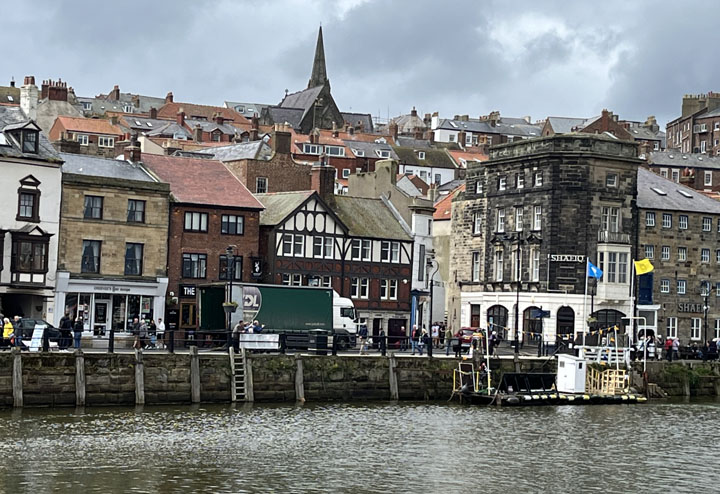
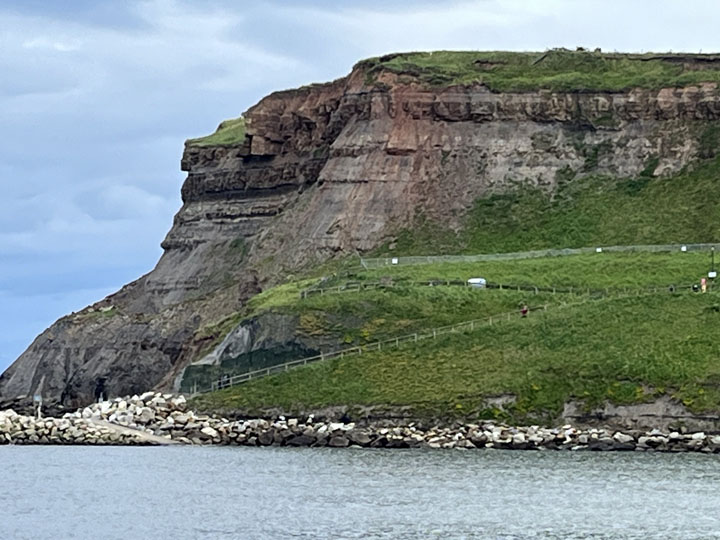
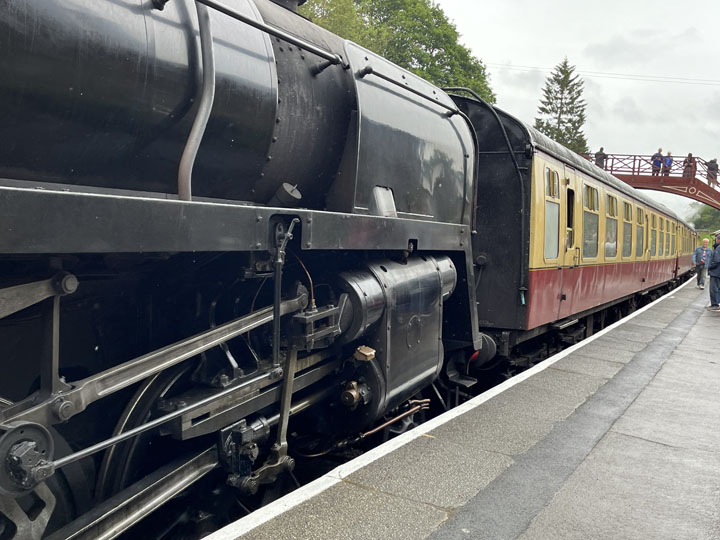
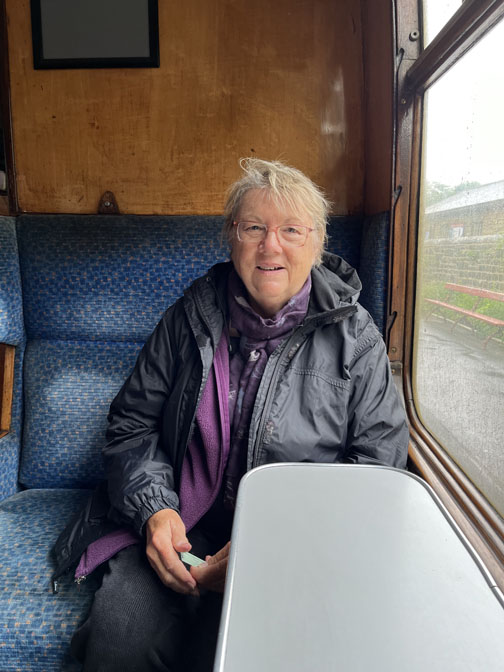
While the seats on this train weren't as comfortable as they might have been, at least we didn't have to stand!
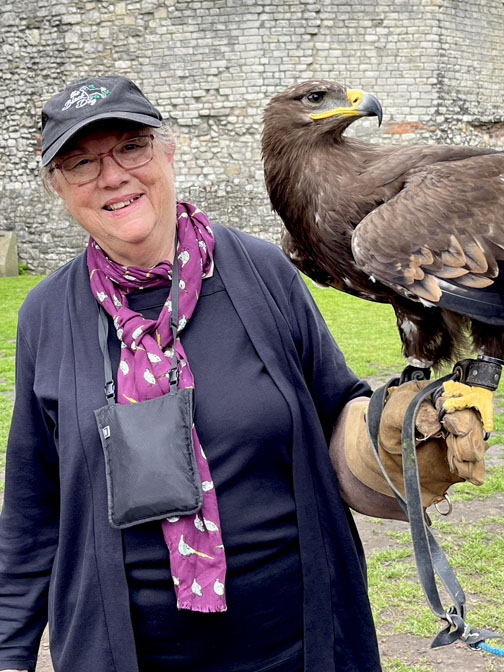 Back to York we went, for a guided walk through some sort of park. There was a man there making his living by letting people—including Yank tourists—hold birds of prey. We'd been to a birds-of-prey demonstration shortly before at a castle whose name I don't remember, and my wife wanted to hold one. She chose a "Steppe eagle," a huge bird with a beak that could have taken her eye out in a flash had he been inclined to do so.
Back to York we went, for a guided walk through some sort of park. There was a man there making his living by letting people—including Yank tourists—hold birds of prey. We'd been to a birds-of-prey demonstration shortly before at a castle whose name I don't remember, and my wife wanted to hold one. She chose a "Steppe eagle," a huge bird with a beak that could have taken her eye out in a flash had he been inclined to do so.
Luckily for her, the bird was in a good mood, and she remained ophthalmologically intact. This bird weighed something like eight pounds, and given the length of his talons, that leather glove she's wearing was really necessary to prevent injury. She said "It was the heaviest eight pounds I ever held!" But she seemed pleased with the Close Encounter Of The Avian Kind.
"Jorvik"
York was, after the Romans left, more or less taken over intact by the Vikings, who were great traders as well as conquerors. In York is a museum, the "Jorvik" Center (sorry, "Centre," of course...) with realistic depictions of what life in Viking York would have been like. You are seated in a moving vehicle that takes you through various scenes of daily existence in an age without baths or toilets. Curiously, my wife's travel notes show that we went to this place in 1993, but neither of us has any memory of doing so.
Evensong At The Minster
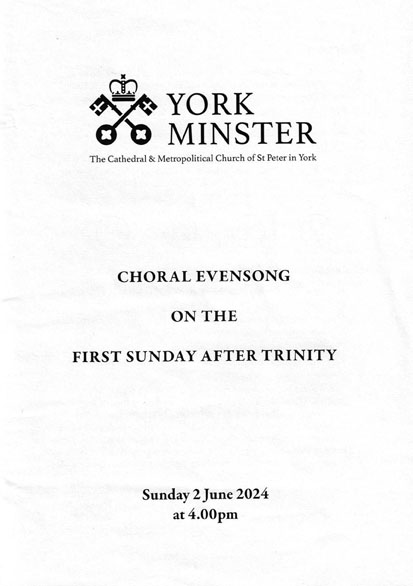 I am the least religious person you'll ever meet. It would be hard to find anyone less interested in religion of any flavor. But you don't have to be a believer to like great music and architecture. We had wanted to see York Minster but were put off by the very steep admission price for a day tour. However, if you attend Evensong (which is of course a religious service) you don't have to pay anything. This we did. I'd been alerted to the Evensong service by a friend, someone whom I've known all my life. He'd also recommended one in the Temple Church in London but we missed that.
I am the least religious person you'll ever meet. It would be hard to find anyone less interested in religion of any flavor. But you don't have to be a believer to like great music and architecture. We had wanted to see York Minster but were put off by the very steep admission price for a day tour. However, if you attend Evensong (which is of course a religious service) you don't have to pay anything. This we did. I'd been alerted to the Evensong service by a friend, someone whom I've known all my life. He'd also recommended one in the Temple Church in London but we missed that.
We got plonked into a pew right alongside the Dean of the Minster and a couple of other high-ranking church officials. Sat through a not-too-terribly-boring sermon and service and enjoyed the music. The interior of the Minster is full of fabulous wood carvings. It took over 200 years to build this cathedral, so I'm glad Henry VIII didn't feel compelled to ransack it.
That pretty much "did" for York: we needed to get on to the next stage, the Cotswolds. Before leaving we had dinner in a garden of a local restaurant. There was a lady there who was cradling her lethally cute Lhasa-Apso/Poodle cross. I've said the British are far smarter than we are about dogs in restaurants. We got to talking with this lady, who was shocked to find out that if we'd done that in the USA we'd have been thrown out.
The Cotswolds
Our first trip to England was in 1989. We went to the Cotswolds, an inconceivably picturesque region of central southwest England. That was a very memorable event, so when my wife was planning our route and stops, the Cotswolds were high up on the Must-See-Again list.
We went to Stow-On-The-Wold. Cotswold towns have names like that. In 1993 we'd spent a month in Stanford-In-The-Vale. To get to Stow-On-The-Wold (to save time I will refer to it as "S-O-T-W" henceforth) we had first to go to Moreton-In-Marsh by train, because S-O-T-W is too small to have a railway station of its own. That was a punishing day, all of ten hours in the trains from York plus another ride in a bus. From M-I-M we had to take a bus at the railway station. It dropped us off only a few yards from the Stow Lodge Hotel.
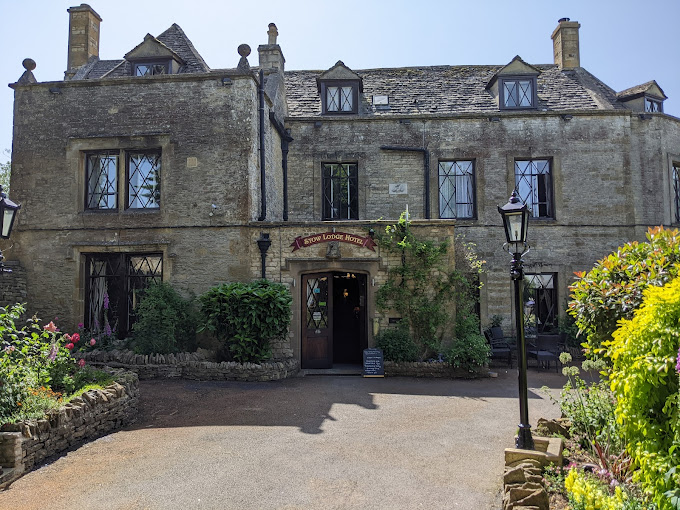
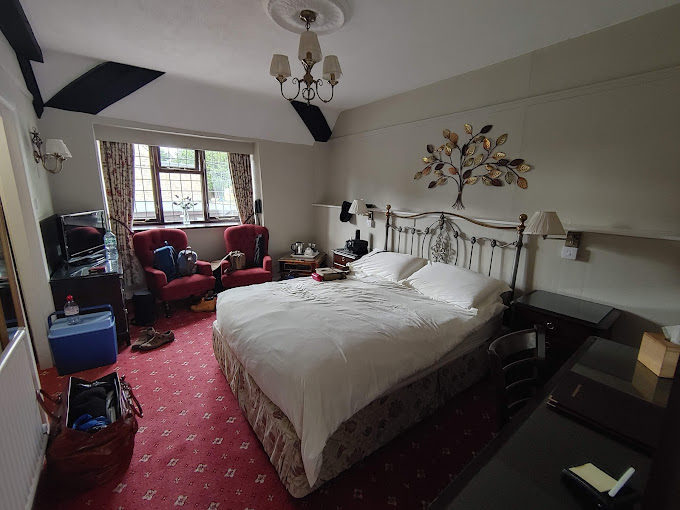
S-O-T-W is a lovely place, with a nice town square and several good places to eat. We had our breakfasts in the hotel. The best pub I encountered in England was in S-O-T-W, the "Queen's Head" on the square. It was very traditional and the food was excellent. The sort of pub you see in movies, not the kind of raucous places we encountered in London and Liverpool. Quiet, clean, and very, very English.
The Stow Hotel is an old vicarage, so there's a church right there next to it. And in that church we encountered yet again a feature of Britain that I always find very moving: the war memorial. In Saint Edward's there was almost an entire wall covered with the names of those who died. Hundreds of them, most from 1914-1918, most of them well under the age of 21. Stow today has a population of 1900 people, but it must have been much smaller in 1914. It's a fair bet that well over half the youth of this tiny place—well over half—died in The Great War. It's simply impossible for a modern day American to comprehend what that means, but even after three generations have passed, the British do. Whatever else she may or may not do, Britain remembers and honors those who died for her.
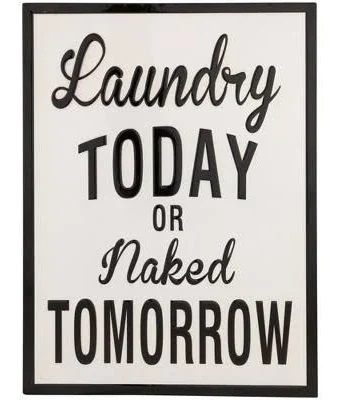 As lovely as S-O-T-W was, it was time to deal again with that plague of all travelers: dirty clothes. Back to the bus, back to Moreton-In-Marsh, where there is a coin-operated laundry. We had enough time while it washed and dried to have lunch around the corner at a little Thai (what else?) restaurant, and also to have an ice cream cone.
As lovely as S-O-T-W was, it was time to deal again with that plague of all travelers: dirty clothes. Back to the bus, back to Moreton-In-Marsh, where there is a coin-operated laundry. We had enough time while it washed and dried to have lunch around the corner at a little Thai (what else?) restaurant, and also to have an ice cream cone.
Then back to S-O-T-W. That little jaunt to the laundry consumed almost an entire day, but it needed to be done, though it cost us £ 16, about $20.
S-O-T-W is also a very dog-friendly place, and while we were there I saw a Cocker Spaniel puppy who looked exactly like my childhood dog, Penny, now 63 years in her grave. That evening we sat in the garden and had a drink or two; I silently toasted her memory.
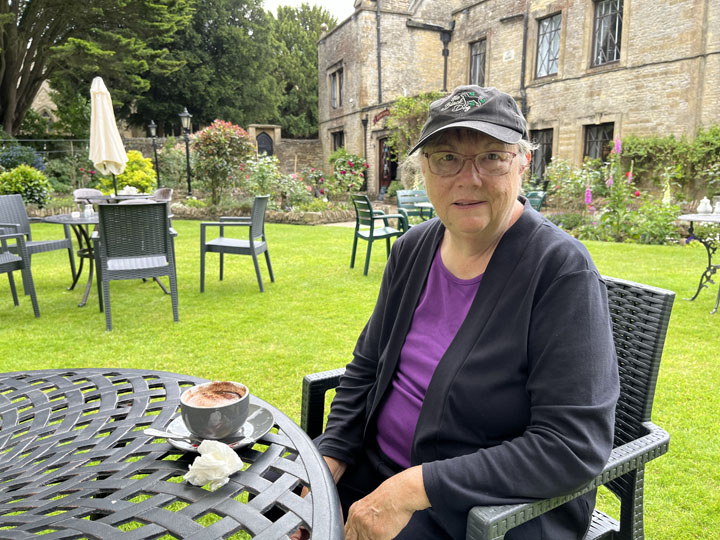
The last Cotswold village we visited was Bourton-on-the-Water. The "water" in this case was the Windrush River, which would hardly qualify as a creek here in Virginia, let alone a river. It was all of a foot deep in places. The banks were lined with restaurants and souvenir shops, it was considerably more commercialized than S-O-T-W. In fact it was almost a Disneyland version of a Cotswold village. But here again some coincidences arose. I grew up in the northwest Bronx in a neighborhood called Kingsbridge. Lo and behold, in Bourton-On-The-Water there is a pub called the "Kingsbridge Inn." It, too, is a very dog-friendly place.
We had a nice lunch at the "Rose Tree Inn" before we left. When we got home my wife dug out her travel notes from 1993: we had eaten there then! Neither of us had any memory of the place at all, but it was unquestionably the same restaurant.
Then it was back to Southampton for the voyage home. Embarkation went smoothly, as did the trip back across The Pond. After landing in New York we spent one night in a hotel near Times Square, thence to Penn Station for 10 hours in a freezing AMTRAK coach back to Roanoke.
S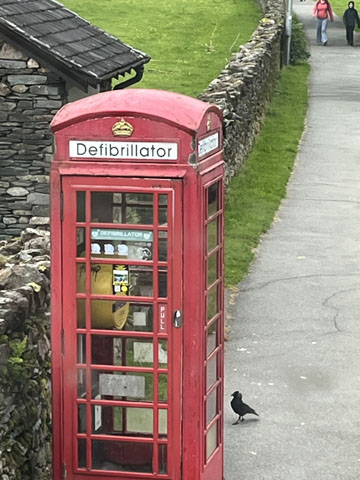 ome Random Observations
ome Random Observations
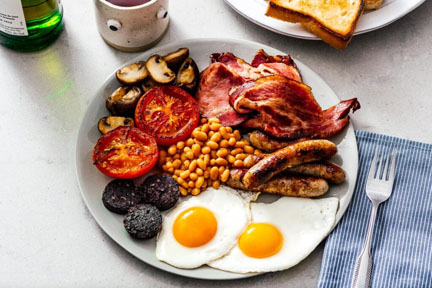 Anyone who's watched any amount of British TV is familiar with those iconic red telephone booths. Well, they're still around but they aren't telephone booths any more. They're defibrillator booths now. Perhaps the British have more heart attacks than Americans do thanks to eating those "Full English" breakfasts which include eggs, bacon, sausage, mushrooms, baked beans (?) and "black pudding," a concoction that to me seems like it is made from sawdust and tar. It seemed that defibrillators were everywhere: in train stations, on the walls of buildings, in the aforementioned ex-phone booths, and sometimes in men's rooms. Maybe they save the National Health Service some money?
Anyone who's watched any amount of British TV is familiar with those iconic red telephone booths. Well, they're still around but they aren't telephone booths any more. They're defibrillator booths now. Perhaps the British have more heart attacks than Americans do thanks to eating those "Full English" breakfasts which include eggs, bacon, sausage, mushrooms, baked beans (?) and "black pudding," a concoction that to me seems like it is made from sawdust and tar. It seemed that defibrillators were everywhere: in train stations, on the walls of buildings, in the aforementioned ex-phone booths, and sometimes in men's rooms. Maybe they save the National Health Service some money?
Speaking of breakfast, someone needs to address the matter of what the British call "pancakes." Theirs are perhaps 4" in diameter and seem to be made of sawdust (unleavened by tar—or anything else). I suggest we enlist the aid of the Cracker Barrel restaurant chain to send some of their people over to teach them how to do pancakes the right way.
Dogs
I've alluded more than once to the very sensible and humane attitude towards dogs in the UK. We first noticed this phenomenon in 1989: I have a vivid memory of a Border Collie sitting under his master's bench in a pub, staring at the crowd and daring anyone to come over and mess with The Boss. In many places we saw "Dogs Welcome" signs. The "default," even if there's no sign, seems to be that dogs are okay to bring in. There's a pub in Windsor, "Sir Woofchester's," that has a specific meal menu for dogs. There are several brands of ice cream formulated for dogs.

Plumbing
 Britain has made great strides in plumbing, but there are some things that need attention. Lavatory sinks with two faucets, one hot and one cold, on either side should be addressed. Newer hotels have mixing faucets, but the older places still cling to the old ways.
Britain has made great strides in plumbing, but there are some things that need attention. Lavatory sinks with two faucets, one hot and one cold, on either side should be addressed. Newer hotels have mixing faucets, but the older places still cling to the old ways.
Then there are the Killer Bathtubs. We encountered these mostly in hotels, but some of the B&B's have them too.
I admire the British for making their bathtubs long enough for a normal human being to lie down in completely (unlike American ones, where even a short guy like me has to bend his legs to fit) but the problem is that they're very deep. Worse, the inside of the tub is several inches higher than the outside. Stepping over the side of the tub to get in isn't a problem, but getting out is. The different heights, with the floor considerably lower than the tub, is treacherous for a wet, slippery Geezer. The grab handles seem not to be positioned for help in getting out. More than once I found myself teetering as I carefully lowered my foot to the floor, wondering if I would fall and hit that lovely glass barrier, slashing my carotid artery, thereby giving the rescue services some work to do.
Ice
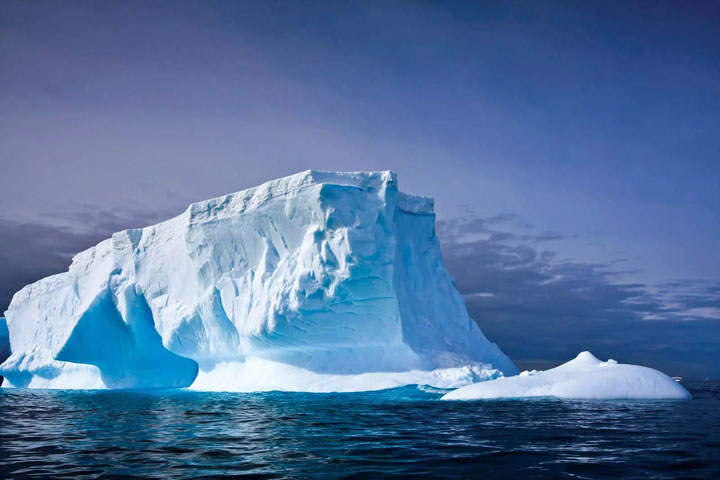
Americans like ice. We are accustomed to having it available on demand in hotels and restaurants. In any half-way decent American hotel there will be an ice machine, often one on every floor. You are provided with an ice bucket in your room, so that you can go down the hall, fill it up, and have all the ice you want.
This no-ice issue is not confined to Britain: I don't think there's any place in Europe where ice is freely available. You can get it in restaurants if you ask: your drink will come with an ice cube the size of a postage stamp. In hotels (even in the new Premier Inns where we stayed) it was nearly unobtainable. In Naples some years ago we had to pay for a bucket of ice.
The solution to this situation is simple. We should recruit an army of Inuits to go over to the Old World as Ice Missionaries, to bring them The Cold, Hard Truth.
Money
Years ago, thank goodness, Britain adopted a decimal currency, abandoning the old system of pounds, shillings, and pence (not to mention guineas, crowns, half-crowns, florins, ha'pennies, farthings, and groats) which was in essence a branch of higher mathematics when it came to paying for something or, worse, getting change. Today a pound has 100 pence, and that's as it should be.
But Britain is fast becoming a totally cashless society. It wasn't uncommon to see signs in stores that said NO CASH ACCEPTED. We were told this was due to "...the Pandemic..." (everything gets blamed on the Pandemic) but I think it's more for convenience of accounting or to deter pilferage than anything else.
All well and good but it gets carried to extremes. Several times we encountered pay toilets that wouldn't take cash. It's bad enough to have to pay to take a piss in the first place but to have to use a tap-to-pay credit card system is simply ridiculous. Pay toilets are an abomination in the sight of The Lord anyway, but cash-free ones are an invention of the Devil.
Tap-to-pay is used on the Underground, at museum entrances, the Post Office, and even on buses. I resolutely used coins on the bus when I could, but most people, hardened to the tap-to-pay system, didn't.
Home Again, Home Again, Jiggety-Jig
I described our arrival in New York in QM2 above. We have long since learned that it's wise to leave a day at each end when there's a travel deadline to be met such as boarding a ship or catching a train, so we always book a hotel room. On the outbound phase we'd been booked into a monstrously over-priced Holiday Inn in Brooklyn (in Brooklyn, for God's sake). Unfortunately, the AMTRAK train that carried us to New York City in great discomfort (the memory is too painful to relate here) stops in Manhattan. So when it was time to go to the Brooklyn Cruise Terminal (Why Brooklyn ? Other cruise ships dock in Manhattan as God intended) we had a $100 cab ride from Penn Station. On the return, because we had to get AMTRAK back to Roanoke, we cleverly booked a hotel in Manhattan, near Penn Station. However this saved us no money because we had a $100 cab ride from Brooklyn to get there. This demonstrates the truth of the saying that "They get you coming and going."
Finis
This post has gone on too long already. We did more than I have recounted (a lot more) but I won't belabor my readers any longer. It was a great trip. Traversing The Pond by ship is indeed "The Only Way To Cross" and I'll never fly to Europe again.
| OPENING PAGE|
|SEASON LOGS |
| HUNTING | GUNS | DOGS |
| FISHING & BOATING | TRIP REPORTS | MISCELLANEOUS ESSAYS |
| CONTRIBUTIONS FROM OTHER WRITERS|
| RECIPES |POLITICS |
